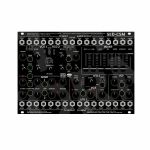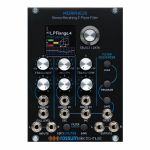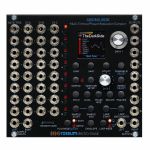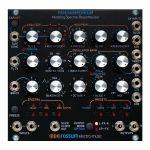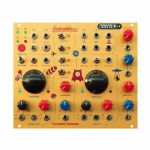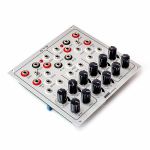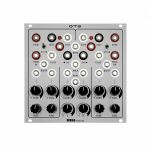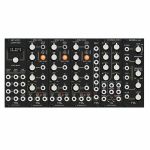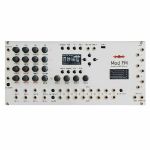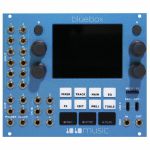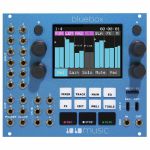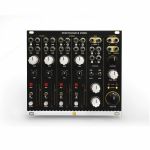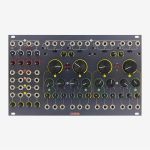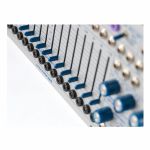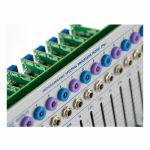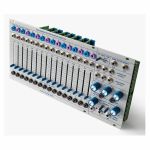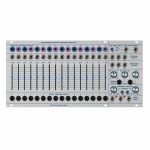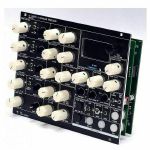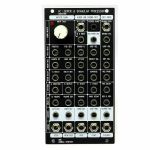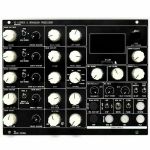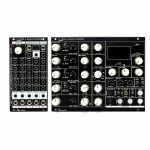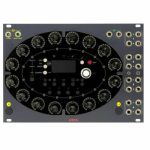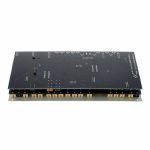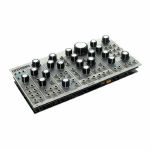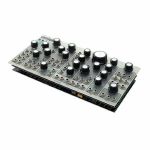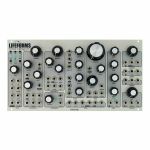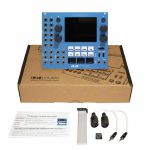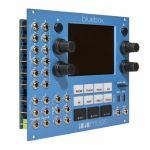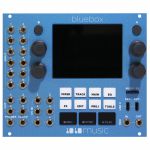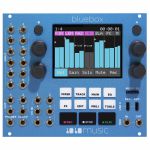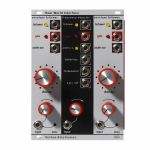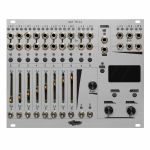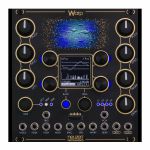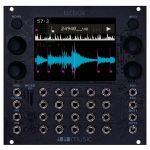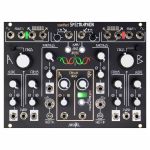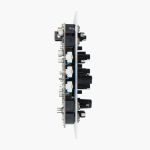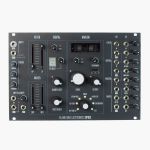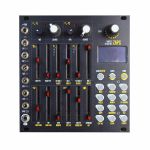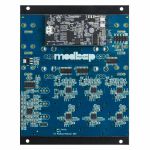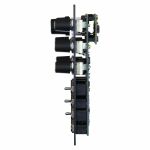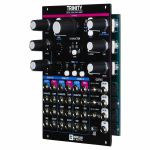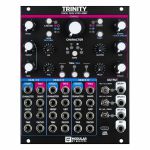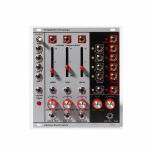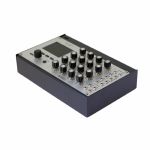Studio equipment
Our full range of studio equipment from all the leading equipment and software brands. Guaranteed fast delivery and low prices.
DJ equipment
Our full range of DJ equipment from all the leading equipment and software brands. Guaranteed fast delivery and low prices. Visit Juno DJ
Filter
Stock
Coming Soon
Equipment
Format
Release Date
Brand
Featured
Price
Tags
The idea
Unlike other generative sequencers in euorack, the Precision Disrupter
offers complete command over the randomization parameters and then immediately empowers you with fine-editing controls for precise, real-time performance punch.
The bottom line
The Precision Disrupter is a melody generating powerhouse. Quickly find the the perfect sequence, breathe in the inspiration, and show them what you are made of.
Width: 40HP
Max Depth: 25mm
200mA @ +12V 5mA @ -12V
This product is available for pre-order at Juno, for shipping on the release date. You won’t be charged until the order is despatched.
We'll keep you informed of your order at every stage, and let you know if the release date changes.
If the price of the item drops before it's released, you will pay the lower price, but if it increases, you'll only pay the price you see today.
If you also include in-stock items on your order, they’ll be charged and shipped within 24 hours as usual.Power consumption: TBA
Rackspace: 36HP
This product is available for pre-order at Juno, for shipping on the release date. You won’t be charged until the order is despatched.
We'll keep you informed of your order at every stage, and let you know if the release date changes.
If the price of the item drops before it's released, you will pay the lower price, but if it increases, you'll only pay the price you see today.
If you also include in-stock items on your order, they’ll be charged and shipped within 24 hours as usual.The MORPHEUS Eurorack module includes over 280 filter configurations, which are called Cubes. Each Cube is composed of up to 8 complex filters that you can picture as being at the corners of a three dimensional cube (hence the name). Morpheus gives you the ability to smoothly interpolate between those 8 filters within the cube's three dimensional space.
Due to processor limitations back in the day, the original Morpheus was capable of real-time morphing in one dimension, but interpolation in the frequency and transform dimensions were set at note-on and remained static for the remainder of the note. But even with that limitation, Morpheus offered sonic capabilities that are unmatched to this day.
With the MORPHEUS filter module, you now have simultaneous real-time CV control of all three dimensions, for dynamic timbral effects unlike anything you've ever heard before. In stereo.
Like all Rossum Electro-Music digital modules, all parameters are available for adjustment with a single button press. No menu diving.
Morpheus Specifications
Filter cubes: 289
Filters: 1000
Filter sequences: 200
Sequence steps: 20,000 Dynamically Allocated
Inputs: Audio L/R
2x 3.5mm mono socket
100kO Input Impedance
Full Level Frequency CV
1x 3.5mm mono socket
100kO Input Impedance
Attenuverted Frequency CV
1x 3.5mm mono socket
100kO Input Impedance
Attenuverted Morph CV
1x 3.5mm mono socket
100kO Input Impedance
Attenuverted Transform/Distortion CV
1x 3.5mm mono socket
100kO Input Impedance
Filter Sequencer Dec
1x 3.5mm mono socket
100kO Input Impedance
1.6V threshold
Filter Sequencer Inc
1x 3.5mm mono socket
100kO Input Impedance
1.6V threshold
Filter Sequencer Reset
1x 3.5mm mono socket
100kO Input Impedance
1.6V threshold
Outputs
Audio L/R
2x 3.5mm mono socket
1kO Impedance
Power requirements
+/-12V via 16-pin, Doepfer-style connector
Current draw
135mA +12V, 25mA -12V (maximum)
Dimensions
18HP (W); Panel to power connector (with connector plugged in) 25mm (D)
Supplied accessories
1x 16-pin, Doepfer-style cable
4x M3 screws
4x M2.5 screws
4x Nylon washers
1x Quickstart Guide
Supplier's Notes:
Designed to provide a powerful, flexible sampling engine for modular synthesis, the ASSIMIL8OR Multi-Timbral Phase Modulation Sampler module is the latest incarnation of Dave Rossum's decades-long pioneering of affordable professional sampling technology.
ASSIMIL8OR provides eight independent channels of sampling with sound quality that can range from extremely hi-fi to low fi, all with extensive real-time CV control.
Assimil8or Specifications
Sample memory
2,300 seconds at 48kHz mono, freely allocatable between the 8 channels
Sample rates
48kHZ, 96kHZ, 192kHZ
A/D & D/A
24 Bits
Internal processing
32 Bits
Latency
100 microseconds at the Mix Outputs
180 microseconds at the Individual Outputs
Inputs
Sample L/R
2x 3.5mm mono socket
100kO Input Impedance
Gate/Trigger 1-8
8x 3.5mm mono socket
100kO Input Impedance
1.6V threshold
Control Voltage A 1-8
8x 3.5mm mono socket
100kO Input Impedance
96 kHz sample rate
Anti-alias filtered to 20kHz bandwidth
Control Voltage B&C 1-8
16x 3.5mm mono socket
100kO Input Impedance
48 kHz sample rate
No anti-alias filtering
Outputs
Mix Outputs L/R
2x 3.5mm mono socket
1kO Impedance
Individual Outputs
8x 3.5mm mono socket
1kO Impedance
Power requirements: +/-12V via 16-pin, Doepfer-style connector
Current draw: 220mA +12V, 30mA -12V
Dimensions: 28HP (W); Panel to power connector (with connector plugged in) 25mm (D)
Supplied accessories:
1x Micro SD card
1x 16-pin, Doepfer-style cable
4x M3 screws
4x M2.5 screws
4x Nylon washers
1x Quickstart Guide
quote 996331
Panharmonium input can be anything from a single oscillator to an entire mix (including vocals). From dense, swirling pads and drones that evolve with the input's changing spectrum, to clock-syncable spectral arpeggiation, to as-yet unnamed harmonic effects, Panharmonium opens up an entirely new world of sonic possibilities.
Additionally, Panharmonium can take a snapshot of an instantaneous spectrum and use that as a complex harmonic oscillator, which can then be modified and modulated by all of Panharmonium's other controls.
Panharmonium accomplishes its magic though a combination of functional submodules:
Spectral Analyzer
The Spectral Analyzer provides tools for defining the analysis process.
- The Slice parameter sets the rate at which the incoming audio is transformed to spectral data. It can be set by the Slice and Multiplier controls, the Tap button, or by an external clock signal. Very short slice times result in real-time spectral data, while longer times can create rhythmic spectral patterns.
- The Center Freq and Bandwidth controls (and associated CV inputs and attenuverters) control the range of frequencies to be analysed. The Bandwidth control allows the selection of narrow to wide pass bands on the left side of the pot and narrow to wide notches on the right side of the pot. The ability to sweep the frequency and modify the bandwidth under CV control opens up a wide range of sonic effects.
- The Freeze button lets you freeze the spectral integrator, sustaining the currently analysed spectrum.
Spectral Modifiers
These controls allow you to creatively modify the analysed spectra.
- The Voice parameter lets you select from 1 to 33 oscillators to resynthesize the spectrum.
- The Blur parameter (and associated CV input) is a spectral lag processor that controls how quickly the spectrum can change.
- The Feedback control lets you route the resynthesized audio back into the entire processing chain for subtle or dramatic feedback effects. At its max, the output becomes self-sustaining, even if the input is removed.
Oscillator Bank
The Oscillator Bank resynthesizes the analysed spectra.
- The Waveform parameter selects the oscillators' waveform. In addition to the usual sine, triangle, sawtooth and pulse waveforms, two special crossfading sine and sawtooth waveforms are included.
- The Freq control lets you tune the oscillators over a +/-7 semitone range. The frequency is further controlled by the 1V/Oct input and the FM input and attenuverter.
- The Octave control, not surprisingly, shifts the pitch of the output by octaves.
- The Glide parameter sets the amount of polyphonic glide (i.e., each oscillator has its own glide circuit).
- The Mix control (and associated CV input) sets the balance between the original input audio and the resynthesized audio.
Optional Functions
A number of optional functions can be selected by using the Output Mode and Tap buttons.
- Holding the Output Mode button and adjusting the Slice control enables Drums Mode, which optimizes the spectral analysis for drums and other percussive inputs.
- Holding the Output Mode button and adjusting the Freq control enables Spectral Warping. In contrast to conventional frequency adjustment, where the harmonic relationships between the spectral elements are preserved, Spectral Warping shifts the harmonic elements individually, producing a variety of clangorous, swarming textures.
- Holding the Tap button and adjusting the Freq control quantizes the resulting frequency adjustments to semitones.
Spectra Memories and Presets
Panharmonium provides 12 user Spectra memories and 12 user Presets.
- The Spectra memories let you store up to 12 frozen slices. When selected, a spectrum (up to 33 oscillators wide!) replaces any live input and can have its pitch controlled by the 1V/Oct input and FM controls.
- A Preset is a snapshot of all of the module settings, along with the value of any CVs present at the moment the preset is saved.
Panharmonium is 26HP wide and 25mm deep.
Power requirements (max): 140mA +12V, 30mA -12V. Reverse polarity protected.
The Furthrrrr Generator has a main oscillator (carrier) with an extensive and fully voltage controllable wave multiplier and a modulation oscillator (modulator) that can cross-modulate the carrier. Each oscillator has hard and soft sync and also features an integrated tuner: if both LEDs are lit the VCO is at note A. Left LED is lit at note Ab and right LED at A#. Frequency potentiometers are ten-turn models and thus allow for easy tuning. Frequency range of the VCOs is 10Hz-10kHz (and much lower in modulator's LFO mode). Both VCOs feature 2 frequency CV inputs (1x with bipolar attenuator, 1x with 1V/octave), one FM input (jumper selectable between linear and exponential FM) as well as separate input for hard and soft sync. The voltage characteristic can be selected between 1V/octave and 1.2V/octave (Buchla norm).
The main oscillator (carrier) outputs the waveforms sine, saw, square and white noise. The two outputs marked with the magic eye are outputs of the "harmonic section" that generates very complex sounds by the wave multiplier and its parameters symmetry, order and Furthrrrr in the module's right-hand section. Symmetry lowers the level of even harmonics and amplifies the odd harmonics (this affects the pulse wave's width as well). Order adds saturation to the high order harmonics and resembles a low pass filter. Furthrrrr alters the level of harmonics set by the other parameters and produces very interesting, partly brute sounds with lots of harmonics by clipping and folding the wave. All three parameters can be voltage controlled. The carrier oscillator also has inputs for hard and soft sync, the sync-switch can synch directly to the modulator.
The modulation oscillator (modulator) has three wave forms with direct outputs: sine, saw and square. Using the internal modulation via the "mood section" the waveform is selected with a button; an additional staircase wave form is available here, but it can be overridden by inserting a signal into the external input socket. A switch activates the LFO mode.
The Mood section is responsible for the internal modulation of the carrier by the modulator. Switches determine the modulation destination(s) that can be activated simultaneously. These are the Furthrrrr parameter of the harmonic section, the amplitude and the frequency of the carrier oscillator. The "balanced" switch activates the ring modulation between both VCOs. intensity of modulation is controlled by the "mood index" potentiometer and the according CV input with bipolar attenuator.
Supplier's Notes:
The Serge GTS is a complete redesign of the famous Serge Dual Universal Slope Generator (DUSG) by Serge himself - with a new core, optimized for speed and tracking. Like some of the clones it can be used for CV, but also provides exceptional audio performance: transient rise times as fast as 13us and a maximum cycle speed of 27kHz.
Some functions for which one Slope Generator can be used:
Function generator for linear, logarithmic, exponential, stepped etc. curves
Integrate an incoming signal
Sawtooth / Pulse oscillator
Add, subtract up to 4 signals
Max and Min function
VC Transient Envelope Generator
VC LFO
VC Portamento device, Envelope Follower (Detector), VC Pulse Delay (Monostable), Sub-Harmonic Series Generator (Divider), Audio Oscillator with variable waveform symmetry (saw to triangle), Non-Linear Audio Processor (low-fidelity VCF).
Serge GTS for eurorack:
Designed by Serge Tcherepnin 2021-2023
Increased audio range (up to >28kHz)
Tracks >5 octaves as a Sawtooth / Pulse oscillator
Temperature stabilized
Eurorack format (3U), 26 hp
Power consumption: 90mA @ +12V, 80mA @ -12V
(NEW) Skiff-friendly: < 25mm (1")
quote 1004982
ART QUAD QUANTIZER is a four channel CV to ART Quantizer to play ART oscillators from CV sequencers, LFOs and anything that outputs CV. This is Tiptop's second ART controller option and is designed for those of us playing ART without a computer or MIDI source. The inputs take in positive, negative, bipolar CV voltages. Scales include Major Minor and the five other modes (Dorian, Lydian, etc). The module is simple to set up with a simple menu and one knob with switch for navigation. The 4th channel can be set to generate Chords and polyphonic note streams for ART Polyphonic oscillators.
Size: 8HP - Depth: 40mm / 1.5"
Power: +12V 38mA / -12V 4mA
ATX1: a classic all analogue saw VCO core with 3 switchable modes, ART, 1V/Oct, LFO and is recommended as the basic building block for ART systems. It is designed for patching analogue polyphonic synths from discrete modules or multi-mono patches in ART mode. When using ART the ATX1 takes care of the tuning including accounting for temperature changes. In 1V/Oct mode the ATX1 runs as a standard old school modular VCO. LFO mode drops the frequency range and is great for patching vibrato to other ATX1s among other things. The ATX1 outputs variable waveshapes with manual or CV control. Classic FM, PWM and hard sync are provided. A dedicated Gate Out in ART mode manages the voice envelopes or any modulation synced to that voice. TipTop consider the ATX1 the best sounding analogue VCO they have ever created.
Size: 8HP - Depth: 40mm / 1.5"
Power: +12V 105mA / -12V 33mA
MIX7 is a seven channel analogue summing mixer module for Eurorack. It is designed for summing any of the different types of signals you'll find in a modular system: Audio, CV, Triggers, or Gate.
MIX7 gives ability to sweeten your mix with more headroom using the power of low noise analogue summing. A compact 3HP Eurorack utility module, MIX7 is an attractive mixing addition to any rig, especially with the ability to also combine rhythms, note patterns or CV automations from different control sources. The main output of one section can be connected to the input of another MIX7 to create larger mixing groups and complex signal routes inside your modular.
The MIX7 summing mixing circuit is built with low-noise operational amplifiers, giving it an excellent sound quality for mixing audio, the beautiful texture of classic analogue mixing with plenty of headroom to handle hot modular signals, and the versatility to sum non-audio signals in your system to open up new creative possibilities.
Each input is labelled with a number of dots, 1-7, yellow for input and green for output. The module matches Tiptop's system look with clean white faceplate styling.
At the back of the module is a user-configurable jumper allowing users to configure the MIX7 for either unity gain (OUT = IN) or give increased headroom (OUT = 0.4IN) for use with hot audio signals, which makes it a great pairing for Tiptop Audio percussive modules. A peak indicator light on the front panel warns the user of even the slightest audio clipping in the mix, helping to keep all the incoming sound sources at their full original quality.
Size: 3HP - Depth: 43mm - Power: +12V 25ma / -12V 20ma
CONTROL PATH is an all in one voice dynamics module that helps build full voices quickly. It contains two analogue envelopes with velocity cv, and one VCA. In a typical voice patch the left envelope will control a filter and the right envelope will be the voice VCA. Velocity control is provided for each envelope and delay front panel trimmers are used to compensate for any miss match between incoming gate signal and velocity CV timings. Envelope cv outs are 0-5V, Velocity cv ins are 0-5V.
Size: 8HP - Depth: 40mm / 1.5"
Power: +12V 50mA / -12V 55mA
The Z2040 is TipTop's redesign of the most famous analogue filter from the polysynths of the 80's and features Tiptop Audio's signature lush, big, and creamy sound. Its frequency sweeps make thick bass lines and leads with great dynamics. When modulated with audio frequencies through its various inputs, the Z2040 gets quite colourful and is capable of creating many new sounds and textures as the forces of the incoming waves and their harmonics blend through the filter's non-linear circuit. When set with Resonance feedback fully up, the Z2040 transforms into a pure sine-core VC-Oscillator, great for making snappy percussive elements and whistling sounds.
A look under the hood will find that the heart of the Z2040 is a discrete design 4-pole low pass filter with a core similar to that of the SSM2040 filter chip, used in the 80's Prophet 5 Rev 2 synthesizer, and its brother the SSM2044, used in the famous early EMU samplers and PPG synthesizers of the 80's. Both filters are considered by many to be, "the best sounding filter ever".
The Z2040's four modulation inputs are built to handle CV and audio signals, enabling deep modulation of the filter core and passing signals. A VC resonance input is provided to modulate and even clip the sine wave produced by the filter feedback loop. A Frequency Modulation input (FM) provides dynamic filter sweeps and the unique VC-FM index allows modulation of the incoming FM signals. On top of that, the Z2040 comes with an audio VCA that can be configured to act upon the input or the output of the filter.
Size: 8HP - Depth: 42mm - Power: +12V 20ma / -12V 20ma
quote 1004144
Supplier's Notes:
The S2 is a promotional bundle that TipTop is offering to users, providing a 33% savings to get you started with ART. With these bundles, TipTop have included an incredible voice: the big, beefy 3 VCO stack. The bundles come in two options: Bundle S1, which uses the ART V/OCT Quantizer as a controller, and Bundle S2, which uses Octopus as a controller. In addition to the controllers, there are three ATX1 analogue oscillators, MIX7 for mixing them with plenty of headroom, and followed by TipTop's beloved 4-pole Z2040 filter that has been with them since day one; it just sounds so good. Finally, we end up with Control Path dual envelope plus VCA dynamics modules. This special price is time limited and while supplies last.
OCTOPUS is a powerhouse ART controller that takes MIDI in via the USB or DIN connector and outputs 8 ART channels with 8 velocity CV plus 8 drum triggers. Together with the ART oscillators the OCTOPUS provide unprecedented simplicity connecting the modular to your computer sequencers, hardware midi sequencers and keyboards. Each ART channel can play polyphonic notes, monophonic notes or create multi-channel polyphony using an internal voice manager. All together OCTOPUS can play more voices and notes from a single controller than ever was possible in modular. Using ART high speed control signals OCTOPUS can maintain low jitter for tight timing. OCTOPUS is TipTop's first ART controller with more to follow, please select between Octopus or ART V/Oct Quantizer to get started with ART. Please note, OCTOPUS is not a 1V/Oct midi to CV and should not be confused as one.
Size: 18HP - Depth: 40mm / 1.5"
Power: +12V 140mA / -12V 100mA
ATX1: a classic all analogue saw VCO core with 3 switchable modes, ART, 1V/Oct, LFO and is recommended as the basic building block for ART systems. It is designed for patching analogue polyphonic synths from discrete modules or multi-mono patches in ART mode. When using ART the ATX1 takes care of the tuning including accounting for temperature changes. In 1V/Oct mode the ATX1 runs as a standard old school modular VCO. LFO mode drops the frequency range and is great for patching vibrato to other ATX1s among other things. The ATX1 outputs variable waveshapes with manual or CV control. Classic FM, PWM and hard sync are provided. A dedicated Gate Out in ART mode manages the voice envelopes or any modulation synced to that voice. TipTop consider the ATX1 the best sounding analogue VCO they have ever created.
Size: 8HP - Depth: 40mm / 1.5"
Power: +12V 105mA / -12V 33mA
MIX7 is a seven channel analogue summing mixer module for Eurorack. It is designed for summing any of the different types of signals you'll find in a modular system: Audio, CV, Triggers, or Gate.
MIX7 gives ability to sweeten your mix with more headroom using the power of low noise analogue summing. A compact 3HP Eurorack utility module, MIX7 is an attractive mixing addition to any rig, especially with the ability to also combine rhythms, note patterns or CV automations from different control sources. The main output of one section can be connected to the input of another MIX7 to create larger mixing groups and complex signal routes inside your modular.
The MIX7 summing mixing circuit is built with low-noise operational amplifiers, giving it an excellent sound quality for mixing audio, the beautiful texture of classic analogue mixing with plenty of headroom to handle hot modular signals, and the versatility to sum non-audio signals in your system to open up new creative possibilities.
Each input is labelled with a number of dots, 1-7, yellow for input and green for output. The module matches Tiptop's system look with clean white faceplate styling.
At the back of the module is a user-configurable jumper allowing users to configure the MIX7 for either unity gain (OUT = IN) or give increased headroom (OUT = 0.4IN) for use with hot audio signals, which makes it a great pairing for Tiptop Audio percussive modules. A peak indicator light on the front panel warns the user of even the slightest audio clipping in the mix, helping to keep all the incoming sound sources at their full original quality.
Size: 3HP - Depth: 43mm - Power: +12V 25ma / -12V 20ma
CONTROL PATH is an all in one voice dynamics module that helps build full voices quickly. It contains two analogue envelopes with velocity cv, and one VCA. In a typical voice patch the left envelope will control a filter and the right envelope will be the voice VCA. Velocity control is provided for each envelope and delay front panel trimmers are used to compensate for any miss match between incoming gate signal and velocity CV timings. Envelope cv outs are 0-5V, Velocity cv ins are 0-5V.
Size: 8HP - Depth: 40mm / 1.5"
Power: +12V 50mA / -12V 55mA
The Z2040 is TipTop#s redesign of the most famous analog filter from the polysynths of the 80's and features Tiptop Audio's signature lush, big, and creamy sound. Its frequency sweeps make thick bass lines and leads with great dynamics. When modulated with audio frequencies through its various inputs, the Z2040 gets quite colorful and is capable of creating many new sounds and textures as the forces of the incoming waves and their harmonics blend through the filter's non-linear circuit. When set with Resonance feedback fully up, the Z2040 transforms into a pure sine-core VC-Oscillator, great for making snappy percussive elements and whistling sounds.
A look under the hood will find that the heart of the Z2040 is a discrete design 4-pole low pass filter with a core similar to that of the SSM2040 filter chip, used in the 80's Prophet 5 Rev 2 synthesizer, and its brother the SSM2044, used in the famous early EMU samplers and PPG synthesizers of the 80's. Both filters are considered by many to be, "the best sounding filter ever".
The Z2040's four modulation inputs are built to handle CV and audio signals, enabling deep modulation of the filter core and passing signals. A VC resonance input is provided to modulate and even clip the sine wave produced by the filter feedback loop. A Frequency Modulation input (FM) provides dynamic filter sweeps and the unique VC-FM index allows modulation of the incoming FM signals. On top of that, the Z2040 comes with an audio VCA that can be configured to act upon the input or the output of the filter.
Size: 8HP - Depth: 42mm - Power: +12V 20ma / -12V 20ma
quote 1004146
This long-awaited FM voice module from Jomox is a self-contained synth in Eurorack format, patchable and compatible with other modules but capable of creating eight-voice polyphonic patches all on its own. Vastly powerful.
Supplier's Notes:
The Mod FM is a completely self-contained 8 voice FM synth in eurorack format, which can create powerful sounds out of the box without lacking the commonly provided CV modulation possibilities.
It provides 4 Operators and 2 LFOs/VCOs per voice. Additionally it has 2 analogue filters and analogue VCAs per voice which apply analogue warmth and depth to the Mod FM, although the FM engine is digital of course.
Each voice has own CV/Gate inputs and an individual output. There is a mix output which separates even and odd voices. Here you can mix internal effects like delay and reverb to the stereo output signal.
Next to the CV/Gate control, the Mod FM has Midi in and out in TRS type A format and a USB C connector which handles Midi too.
Even without diving too much into complicated modular setups you can create extremely good sounding and metallic FM sounds, snappy bases but also soft and deep sounding analogue style sounds.
Furthermore, the Mod FM offers a variety of external cv modulations in order to e.g. modulate each operator individually or control the FM envelopes.
The Mod FM is fully multitimbral, i.e. each voice can play an own sound in Multi Mode which gets stored as a complete multi set (not only vectorized). That is, you can copy a single sound to the desired multi, but editings made on that particular multi get stored along with the multi set.
Hence, we have the biggest advantage of the hybrid approach:
Modular is great but can be very complex, and you might be trapped in a system where you never reach again the desired sound of the latest session. Storability certainly helps.
The different sections in more detail:
Matrix FM:
4 operators are arranged in a matrix, in which every operator (= sine oscillator) can be modulated by each one of the other three.
The 16 endless potentiometers of the matrix adjust the modulation amount (FM amt) and the base frequency of the operators.
For each operator you can change the base frequency by the diagonal knobs.
There are several overtone modes that determine if one operator is controlled by the keynote (or CV) = base operator, or if it's locked in as overtone (= overtone operator) to the assigned base operator. For the base operator, the number resembles xxx semitones added to the keynote.
For the overtone operator, the adjusted number is the xxx = Nth overtone or harmonics to the base operator frequency.
The locked overtone operator tracks the base operator and is still able to modulate and being modulated.
Each operator has an ADSR envelope. This envelope can also be used to frequency-modulate the operator.
Algorithm:
The algorithms from the known FM synthesis are actually special cases to the whole matrix.
Because it gets pretty quickly uncontrollable if you turn all the knobs because of the feedbacks, Jomox have decided to implement the algorithms. There are 26 algorithms, that are derived from the DX9 with its 4 operators.
At this menu it's even possible to change the frequency mode of each operator to a fixed frequency that is edited in single Hz and which does not follow the keynote, but only modulation. That makes sense for e.g. percussive sounds.
LFO/VCO:
Each voice has 2 LFOs which can modulate either the frequency (FM) or the amplitude (AM) of an operator. Every LFO addresses 64 different wave forms that are displayed in the right OLED display.
There is another feature: each LFO can be switched into a VCO that covers the whole audio range. You can even mix it into the signal chain and it tracks to the keynote. The former LFO rate parameter turns into a detune parameter. That is, you can create classic sounding rectangle/sawtooth analogue basses or string pads - and much more of course.
Filter:
Each voice contains an analogue filter which is build up with the chip SSI2140 from Sound Semiconductor, which is an improved modern version of the old SSM2040, designed by Dave Rossum, and which had been used in Oberheim synths and the early SCI Prophet-5.
The filter has a classic 24dB output and a 12dB state-variable multimode-filter. The three basic characteristic outputs LP/BP/HP can be cross-faded continuously with one parameter called shape.
Both filter outputs 24dB/12dB can be mixed independently.
The ADSR for the filter is fast and cuts in very quick and directly, the resonance is well adjustable.
The filter section contains an own LFO for the cutoff which is independent from the digital sound engine and has also 64 waveforms.
The VCA is a fast transistor-VCA which is important for snappy sounds. The same transistor-VCA is used in all Jomox drum products. Therefore the ModFM can be used as a rich source for technoid drums and percussions of any kind.
1 in stock $889.22
Oof. Frap casually serve up one of the best filters we've seen in a long time. Quad multimode circuits with saturation and feedback give you extensive routing options. Delicious.
Supplier's Notes:
cunsa /'cu?nsa/ s.f. [dialect of Modena of uncertain etymology, probably from a Latin *comptiare, derived from comptus, participle of comere 'organize,' 'decorate'] i curing, seasoning (of foods), tanning (of leathers).
Seasoning is crucial for cooking. It is a process that enhances the flavors, glues the ingredients together, and even adds some unexpected kick.
From a gentle refining touch to a shovelful of spice, CUNSA is the perfect seasoning tool for your patches. It can sweeten a sour lead or beef up an insipid bass line, and anything in between.
And, just like a good oil, you can even taste it by itself!
CUNSA is a quadruple analog pingable multimode resonant filter, saturator, mixer, and oscillator.
It is Frap Tools' sound seasoning tool: it can gently even a patch, applying a final touch, or it can set it on fire with a ridiculous amount of spice. It's up to you and your cooking style!
It consists of four multimode resonant filters with a custom saturation and feedback control that you can use independently or in various combinations and roles thanks to a series of seminormalizations.
Four Analogue Resonant Multimode Filters
CUNSA features four state-variable filters that can be used independently or linked and mixed. Each filter provides three behaviors simultaneously: lowpass, bandpass, and highpass. Each behavior has a 12 dB/oct slope, except for the lowpass, which can be either 12 or 24 dB/oct.
Unique 'Character' Circuit for Feedback and Distortion
CUNSA handles feedback and gain staging with extreme control and versatility. Besides the usual Q control that emphasizes the cutoff frequency, the Character circuit defines the amount of soft clipping when the filter overloads. High clipping guarantees a controlled behavior with fat tone and pure resonance, while low or no clipping lets the signal saturate the filter stages and make it scream.
V/oct Tracking and Quadruple Oscillator
Each filter responds to the V/oct signal with excellent tracking. It is thus possible to move the cutoff frequency along with the main melody or make CUNSA resonate with no input and transform it into a multiple oscillator. The V/oct inputs are seminormalled so you can control more filters with the same CV. Easy chords stabs!
Ping and Ring
CUNSA is ideal for percussive and organic tones. The Ping circuit offers a behavior similar to the BRENSO but AC-coupled. Instead of shooting the frequency to the moon with any trig, CUNSA gently responds to different incoming gates with a selectable decay curve. The Ping circuit can thus create natural decay sounds when fed with trigs or smoother envelopes with any other voltage, like a linear integrator with a custom decay.
Besides this, you can also feed the filter's audio input with trigs and make it ring at high Q settings.
Linked or Individual Filtering
The four filters can work independently or arranged in groups through seminormalled inputs and sum outputs. CUNSA can thus be a 4×1, 2×2, or a massive 1×4 filter. Even odd configurations are possible, like 1+2+1 or 3+1. Mono, stereo, or quadraphonic audio is at your fingertips.
Filter and Combo Behaviour
When the filter behavior is set to COMBINED, every control of the cutoff frequency also affects the input VCA, reducing the signal amplitude and saturation as it approaches the lowest range. It can make organic decays with the ping circuit or tame the low range at high Q and Character settings.
Four Seminormalizations for Group Use
Four inputs have a cascaded seminormalization: audio inputs, VCA CV, V/oct, and Ping. Every signal patched to a filter will thus feed also those at its right, making simultaneous use even simpler. To remove a seminormalization, simply patch a dummy cable to the corresponding input.
Analog Mixing Stage and Group Outputs
Every filter output can be routed to an analogue mix bus that sums the four filters and outputs them in three combinations: all, 1+2, and 3+4. These outputs allow for versatile audio processing. Just like we did with FUMANA, we added a gentle shelving EQ for the higher frequencies of the All output to provide additional timbral variety.
CV Inputs with Attenuators
Besides the seminormalled inputs, every filter features additional CV inputs for cutoff frequency, Q, and Character, each with a dedicated attenuverter.
The Tiptop Audio Buchla Model 296t is a 16 band spectral resonator & vocoder based on the original Buchla 296.
The 296 was first introduced in 1978 and very few were ever made. Making a module of such complexity at a time when electronic schematics were drawn with pencils, with 48 filters that were most likely hand-calculated is just incredible.
The 70's were a great era of exploration and proof of audio electronics scientific theories, but for Don Buchla it seems like it was always something beyond theory.
The 296 might at first look like an equalizer, but Don Buchla had totally different ideas for it. He managed to pack into it a 16-band analogue modular spectral processor, a cross-band vocoder, plus a massive amount of patch points to work with his synthesizer system.
Eurorack version of 1010's superb Bluebox. Vast power in 30 HP, with the ability to mix, record and play back in mono and stereo, hook up to a computer over USB for stereo I/O and run effects, all with CV control.
Supplier's Notes:
The bluebox Eurorack edition is the new Eurorack mixer with effects and multichannel recording/playback based on the award-winning bluebox desktop mixer. With the Eurorack edition's USB-C EXT port, you can send 2 channels of audio to and from your computer. Plus, you can control up to 6 mix settings with the 6 CV inputs. Whether recording your Eurorack jams, using it to play stems as backing tracks, or a combination of both - bluebox Eurorack edition will rock your rack!
Connect your eurorack, sampler, drum machine, and synthesizer outputs to 12 mono, 3.5 mm inputs and map them to 12 mono tracks or 6 stereo tracks - all with independent control for recording and playback. Connect your computer to the USB C port to send and receive two channels of audio.
The bluebox Eurorack edition is the ultimate in compact mixing, effects, recording, and playback for Eurorack. Smack it in your rack and hit the road with a self-contained, electronic music powerhouse!
When you purchase a bluebox Eurorack edition, you will receive:
a bluebox Eurorack edition 30 HP Eurorack module
A microSD card with bluebox firmware and pre-loaded project files
two Eurorack power cables
a bluebox Eurorack edition Quick Start guide
two MIDI Adapters
Technical Specs
Dimensions & Power
30 HP
Module dimensions including knobs: 6" x 5"x 1.6"
Depth behind front panel with ribbon cable: 1.0"
Requires the +5V rail which may not be present
on some older racks.
Uses 500-850mA at +5V (depending
on screen brightness), 320 mA at +12V, and 82mA at -12V
Requires two power connections
Capabilities
12 mono tracks, 6 stereo tracks or something in between
Connect to TRS or USB C MIDI for beat syncing effects
Lots of headroom with support for Eurorack levels up to +/-5V inputs and outputs
3 effects: reverb, delay and compressor
Records and plays back 48k, 24-bit audio WAV files
4 band EQ per track
Durable aluminum faceplate
Stream 2 channels of audio in and out over USB C
Inputs and Outputs
12 mono 3.5 mm TS inputs
2 independently controlled 3.5 mm TS output pairs that can be used as 4 mono outputs
1 stereo 3.5 mm headphone output
6 CV Inputs
1 USB C MIDI Device port
1 TRS MIDI Input
1 TRS MIDI Output
1 USB C Ext jack for streaming audio
3.5" touch screen, 4 knobs, 8 navigation buttons and 3 transport buttons
This long-awaited FM voice module from Jomox is a self-contained synth in Eurorack format, patchable and compatible with other modules but capable of creating eight-voice polyphonic patches all on its own. Vastly powerful.
Supplier's Notes:
The Mod FM is a completely self-contained 8 voice FM synth in eurorack format, which can create powerful sounds out of the box without lacking the commonly provided CV modulation possibilities.
It provides 4 Operators and 2 LFOs/VCOs per voice. Additionally it has 2 analogue filters and analogue VCAs per voice which apply analogue warmth and depth to the Mod FM, although the FM engine is digital of course.
Each voice has own CV/Gate inputs and an individual output. There is a mix output which separates even and odd voices. Here you can mix internal effects like delay and reverb to the stereo output signal.
Next to the CV/Gate control, the Mod FM has Midi in and out in TRS type A format and a USB C connector which handles Midi too.
Even without diving too much into complicated modular setups you can create extremely good sounding and metallic FM sounds, snappy bases but also soft and deep sounding analogue style sounds.
Furthermore, the Mod FM offers a variety of external cv modulations in order to e.g. modulate each operator individually or control the FM envelopes.
The Mod FM is fully multitimbral, i.e. each voice can play an own sound in Multi Mode which gets stored as a complete multi set (not only vectorized). That is, you can copy a single sound to the desired multi, but editings made on that particular multi get stored along with the multi set.
Hence, we have the biggest advantage of the hybrid approach:
Modular is great but can be very complex, and you might be trapped in a system where you never reach again the desired sound of the latest session. Storability certainly helps.
The different sections in more detail:
Matrix FM:
4 operators are arranged in a matrix, in which every operator (= sine oscillator) can be modulated by each one of the other three.
The 16 endless potentiometers of the matrix adjust the modulation amount (FM amt) and the base frequency of the operators.
For each operator you can change the base frequency by the diagonal knobs.
There are several overtone modes that determine if one operator is controlled by the keynote (or CV) = base operator, or if it's locked in as overtone (= overtone operator) to the assigned base operator. For the base operator, the number resembles xxx semitones added to the keynote.
For the overtone operator, the adjusted number is the xxx = Nth overtone or harmonics to the base operator frequency.
The locked overtone operator tracks the base operator and is still able to modulate and being modulated.
Each operator has an ADSR envelope. This envelope can also be used to frequency-modulate the operator.
Algorithm:
The algorithms from the known FM synthesis are actually special cases to the whole matrix.
Because it gets pretty quickly uncontrollable if you turn all the knobs because of the feedbacks, Jomox have decided to implement the algorithms. There are 26 algorithms, that are derived from the DX9 with its 4 operators.
At this menu it's even possible to change the frequency mode of each operator to a fixed frequency that is edited in single Hz and which does not follow the keynote, but only modulation. That makes sense for e.g. percussive sounds.
LFO/VCO:
Each voice has 2 LFOs which can modulate either the frequency (FM) or the amplitude (AM) of an operator. Every LFO addresses 64 different wave forms that are displayed in the right OLED display.
There is another feature: each LFO can be switched into a VCO that covers the whole audio range. You can even mix it into the signal chain and it tracks to the keynote. The former LFO rate parameter turns into a detune parameter. That is, you can create classic sounding rectangle/sawtooth analogue basses or string pads - and much more of course.
Filter:
Each voice contains an analogue filter which is build up with the chip SSI2140 from Sound Semiconductor, which is an improved modern version of the old SSM2040, designed by Dave Rossum, and which had been used in Oberheim synths and the early SCI Prophet-5.
The filter has a classic 24dB output and a 12dB state-variable multimode-filter. The three basic characteristic outputs LP/BP/HP can be cross-faded continuously with one parameter called shape.
Both filter outputs 24dB/12dB can be mixed independently.
The ADSR for the filter is fast and cuts in very quick and directly, the resonance is well adjustable.
The filter section contains an own LFO for the cutoff which is independent from the digital sound engine and has also 64 waveforms.
The VCA is a fast transistor-VCA which is important for snappy sounds. The same transistor-VCA is used in all Jomox drum products. Therefore the ModFM can be used as a rich source for technoid drums and percussions of any kind.
out of stock $845.91
Supplier's Notes:
Performance Mixer serves as a central control and mixing hub for your modular system, allowing you to combine and shape multiple audio signals from various sound sources.
But what really makes it stand out is its Knob recording feature. Just hit REC, twist the knob, and let the module record your moves.
4 different areas
MONO
Channels 1 . 2
Volume, Panning and Auxiliary send controls with CV for each function.
Knob recording (REC), CUE bus and MUTE function are operated through the switches.
STEREO
Channels 3 . 4
Same as MONO Channel, but the CV for the AUX function is replaced by the right (R) audio input.
AUXILIAR
2 Mono Sends (X & Y) with pre-fader / post-fader selector for each channel.
2 Stereo Returns with volume adjust.
MASTER
Master volume adjust for the main outputs with vu-meter for checking the signal levels.
Headphone output with volume and cue/mix blending knob.
Knob Recording.
Easily record and loop the movements of AUX, PAN and VOLUME controls on each channel, adding depth and dynamism to your sound.
Just press the REC button and then move the desired knobs to start recording.
MUTE LED
The light on the MUTE button not only shows whether each channel is muted or not, but also gives information about the status of its Knob Recording function.
Specifications
Dimensions 28HP - 142,2×128,5mm
Current 200 mA +12V / 125 mA -12V / 0 mA +5V
Input & Output Signals +/-10V
Impedance Input 10k - Output 10k
Materials PCB and Panel - FR4 1,6mm
Depth 40mm including connectors (Skiff friendly)
Supplier's Notes:
cunsa /'cu?nsa/ s.f. [dialect of Modena of uncertain etymology, probably from a Latin *comptiare, derived from comptus, participle of comere 'organize,' 'decorate'] i curing, seasoning (of foods), tanning (of leathers).
Seasoning is crucial for cooking. It is a process that enhances the flavors, glues the ingredients together, and even adds some unexpected kick.
From a gentle refining touch to a shovelful of spice, CUNSA is the perfect seasoning tool for your patches. It can sweeten a sour lead or beef up an insipid bass line, and anything in between.
And, just like a good oil, you can even taste it by itself!
CUNSA is a quadruple analog pingable multimode resonant filter, saturator, mixer, and oscillator.
It is Frap Tools' sound seasoning tool: it can gently even a patch, applying a final touch, or it can set it on fire with a ridiculous amount of spice. It's up to you and your cooking style!
It consists of four multimode resonant filters with a custom saturation and feedback control that you can use independently or in various combinations and roles thanks to a series of seminormalizations.
Four Analogue Resonant Multimode Filters
CUNSA features four state-variable filters that can be used independently or linked and mixed. Each filter provides three behaviors simultaneously: lowpass, bandpass, and highpass. Each behavior has a 12 dB/oct slope, except for the lowpass, which can be either 12 or 24 dB/oct.
Unique 'Character' Circuit for Feedback and Distortion
CUNSA handles feedback and gain staging with extreme control and versatility. Besides the usual Q control that emphasizes the cutoff frequency, the Character circuit defines the amount of soft clipping when the filter overloads. High clipping guarantees a controlled behavior with fat tone and pure resonance, while low or no clipping lets the signal saturate the filter stages and make it scream.
V/oct Tracking and Quadruple Oscillator
Each filter responds to the V/oct signal with excellent tracking. It is thus possible to move the cutoff frequency along with the main melody or make CUNSA resonate with no input and transform it into a multiple oscillator. The V/oct inputs are seminormalled so you can control more filters with the same CV. Easy chords stabs!
Ping and Ring
CUNSA is ideal for percussive and organic tones. The Ping circuit offers a behavior similar to the BRENSO but AC-coupled. Instead of shooting the frequency to the moon with any trig, CUNSA gently responds to different incoming gates with a selectable decay curve. The Ping circuit can thus create natural decay sounds when fed with trigs or smoother envelopes with any other voltage, like a linear integrator with a custom decay.
Besides this, you can also feed the filter's audio input with trigs and make it ring at high Q settings.
Linked or Individual Filtering
The four filters can work independently or arranged in groups through seminormalled inputs and sum outputs. CUNSA can thus be a 4×1, 2×2, or a massive 1×4 filter. Even odd configurations are possible, like 1+2+1 or 3+1. Mono, stereo, or quadraphonic audio is at your fingertips.
Filter and Combo Behaviour
When the filter behavior is set to COMBINED, every control of the cutoff frequency also affects the input VCA, reducing the signal amplitude and saturation as it approaches the lowest range. It can make organic decays with the ping circuit or tame the low range at high Q and Character settings.
Four Seminormalizations for Group Use
Four inputs have a cascaded seminormalization: audio inputs, VCA CV, V/oct, and Ping. Every signal patched to a filter will thus feed also those at its right, making simultaneous use even simpler. To remove a seminormalization, simply patch a dummy cable to the corresponding input.
Analog Mixing Stage and Group Outputs
Every filter output can be routed to an analogue mix bus that sums the four filters and outputs them in three combinations: all, 1+2, and 3+4. These outputs allow for versatile audio processing. Just like we did with FUMANA, we added a gentle shelving EQ for the higher frequencies of the All output to provide additional timbral variety.
CV Inputs with Attenuators
Besides the seminormalled inputs, every filter features additional CV inputs for cutoff frequency, Q, and Character, each with a dedicated attenuverter.
The 296 was first introduced in 1978 and very few were ever made. Making a module of such complexity at a time when electronic schematics were drawn with pencils, with 48 filters that were most likely hand-calculated is just incredible.
The 70's were a great era of exploration and proof of audio electronics scientific theories, but for Don Buchla it seems like it was always something beyond theory.
The 296 might at first look like an equalizer, but Don Buchla had totally different ideas for it. He managed to pack into it a 16-band analogue modular spectral processor, a cross-band vocoder, plus a massive amount of patch points to work with his synthesizer system.
One of the most impressive granular synthesis approaches in Eurorack, combining looping and granular effects with buffer sizes up to five minutes. Hugely creative and powerful dual-module setup.
Supplier's Notes:
There's a long history behind the granular concept and many reinterpretations of it's core principles, this is ADDAC's take on it.
In a loose description digital Granular refer to pieces of sound files being played at the same time with slight or completely different parameters originating what is commonly referred to as granular clouds. Normally there's a buffer size from which the granular engine snips it's pieces from and plays them according to the parameters set. This buffer size is normally small in size where grains are so small that can reach the hearing spectrum and be heard as a sort of ever changing complex wavetable, this is the principle behind granular synthesis.
ADDAC have added the possibility of long buffer sizes up to 5 minutes, allowing "softer" approaches to the granular principle using it as an effect that can generate from "accidental" effects like slight "stutters" to extreme processing and transformation of any incoming audio signal.
This module is conceptually deep but easy to grasp and operate as all controls are in its dedicated panel, all jack inputs and outputs have its own separate panel to allow no compromise when playing it's controls.
There are three main sections in this module:
Looper Engine: The Looper is where all the Real-Time recording happens. The audio input feeds the recording buffer, multiple controls allow to record and play loops into a list so that any sample in the list can be accessed at ay time and more acting as a standard looper
Granular Engine: The Granular acts upon the buffer of whatever LOOP is selected.
Output Mix The output mix allow individual control for the Dry Input, Looper Volume and Grains Volume.
Besides these main sections there's also a simple strip down MENU mainly used to LOAD and SAVE Banks, no Menu diving guaranteed.
For more detailed info, please refer to the User's Guide.
Audio Specs:
Audio input: Stereo, 16bit 44.1Khz
Audio output: Stereo, 16bit 44.1Khz
Tech Specs:
32HP + 13HP
4.5cm deep
240mA +12V
70mA -12V
out of stock $555.22
USTA is a 4×4 tracks sequencer for voltages and gates with variable stage duration, designed to quickly see and edit multiple voltage relationships in real time.
Variable stage duration means that every single stage duration can be individually set in relation to the clock, instead of being constrained to a one-to-one ratio (i.e. one stage per every clock impulse).
4×4 tracks means that every stage can store and generate up to four separate voltages (two CVs and two gates), and that up to four independent stage sequences can be arranged into as many different tracks.
Its architecture is based on an array of 16 'Stages' which form a 'Pattern'; 16 patterns form a 'Track', and four tracks form a 'Project'. Within each track, each stage can provide two gates and two CVs, and a wide set of options is available to define and modify the value of each output ('Layers') and the way it is played ('Colours').
Every Stage is related to a dedicated stepped encoder for quick and intuitive editing, and all the 16 encoders are arranged in an oval layout with a circular playhead. Every encoder is surrounded by a ring of 16 LEDs and a RGB led, to provide a visual feedback of the current setting of that step basing on the layer you are working on (like raw CV, quantized CV, length, gate...) and the way it should play depending on the RGB colour.
out of stock $601.99
The Heart and Soul of Modular Synthesis:
The Pittsburgh Modular Synthesizers Lifeforms SV-1 is a complete dual oscillator synthesizer, designed to be the core of your eurorack modular system. Building on the sound and legacy of our celebrated Waveforms oscillator, the SV-1 module features two full-range independent analog oscillators; sound sources that are perfect for dynamic and inspired performances. In addition to these two high-performance oscillators, we stuffed the SV-1 with a perfectly curated set of modular synthesis tools including dual, chained mixers, a plucky, four stage envelope generator, and of course, our legendary analog state-variable filter.
The Lifeforms SV-1 is a synthesizer powerhouse, providing absolutely everything you need to create gigantic and iconic synth sounds: roaring bass, shimmering leads, lush pads and warm drones are only a few knob turns away. Instantly, out of the box, a rich feature set with a fluid, easy to understand interface empowers you to create vibrant, thick tones. Modulation and Tools sections fill out the analog SV-1 modulation capabilities with a triangle and square LFO, two sub-octave oscillators chained to the main oscillator, and noise with sample & hold.
Your Sound, Your Way:
Pre-patched under the hood, patch cables are not necessary to get started. But as soon as you begin patching, you will feel the power provided by the 53 patch points and 21 knobs. By breaking each feature of the synthesizer out with patch cables, a tremendous amount of flexibility and control emerges to patch up any sound your imagination can dream up. All the tried and true analog classics are there at your disposal: sine, sawtooth, triangle and square. In addition, our exclusive and powerful blade wave on Oscillator 1 adds a unique weapon to your sonic arsenal. Deep modulation options award you complex control of nearly every function of the SV-1.
A Team Player:
We've designed the Lifeforms SV-1 to be the perfect centerpiece of any eurorack synthesizer regardless of size. In a smaller system, the SV-1 provides a wide variety of synthesis options through a hefty set of synthesis tools. Combined with a larger collection of modules, you can unlock never-before-heard expressiveness and unparalleled control over the rich feature set of the SV-1. The ability to patch and integrate the SV-1 with other existing eurorack compatible gear gives you truly infinite modulation and expansion options.
Feature Set/Comparison:
Audio Source:
Lifeforms SV-1 - 2 Oscillators: 5 waveforms + 2 sub octaves and 4 waveforms, respectively
Moog Mother-32 - 1 Oscillator: 2 waveforms
Make Noise 0-Coast - 1 Oscillator: 2 waveforms
Patchability:
Lifeforms SV-1 - 53 patch points (20 in, 32 out, 1 dual purpose). Fully modular (all section in/out points accessible separately)
Moog Mother-32 - 32 patch points (18 in, 14 out). Semi-modular (some section in/out points inaccessible)
Make Noise 0-Coast - 27 patch points (14 in, 13 out). Fully modular (all section in/out points accessible separately)
Mixing:
Lifeforms SV-1 - 4 channel mixer, splittable into 2x2 channel mixers
Moog Mother-32 - 2 channel mixer
Make Noise 0-Coast - Ext. audio input
Sound Shaping:
Lifeforms SV-1 - 3-state variable filter (Low/High/Bandpass)
Moog Mother-32 - 2-state variable filter (Low/High)
Make Noise 0-Coast - Additive synthesis (wavefolding, overtones), no filter
Modulation:
Lifeforms SV-1 - 4 stage ADSR, 2 multi-waveform LFOs, 2 noise sources + smooth and stepped S&H
Moog Mother-32 - 2 stage AD + Sus. switch, 1 multi-waveform LFO, 1 noise source
Make Noise 0-Coast - 3 stage ASD, 1 dual-purpose AD/LFO, S&H + offset
*For audio demos, please visit - http://www.lifeformsmodular.com/sv-1/
out of stock $520.84
***Now featuring Assimil8or Software Version 2.0! Available to download here: http://www.rossum-electro.com/products/assimil8or/
The ASSIMIL8OR is a CV/Gate-controllable sampler with eight independent channels. Each channel is not only its own voice, but also has a separate audio output and a gate/trigger and three CV inputs. Given ever get two sample inputs and main outputs. Thus, Stereo Sampling and playback is possible. Mixed operation of stereo or mono is possible and is limited only by the maximum number of eight channels or parts.
The ASSIMIL8OR works with high-quality 24-bit AD and DA converters. Internally, however, sample and bit rate for lo-fi sound can be lowered, the latter is even CV-controllable. The samples can also be otherwise manipulated in many ways. Thus, the phase of a sample via CV or a different sample can be modulated. Likewise, the loop points can be controlled and the sample can be traversed with CV control (scrubbing), whereby wavetable similar effects could be achieved. The following parameters can be addressed via the gate / trigger and CV inputs:
- Pitch
- Level
- Bit Depth
- Phase Modulation
- Pan
- Scrub
- Sample Start
- Sample Length
- Loop Start
- Loop Length
- Release Decay
Samples and presets are stored on an SD card, which is easily accessible plugged into the module front.
out of stock $882.21
Supplier's Notes:
The Mod FM is a completely self-contained 8 voice FM synth in eurorack format, which can create powerful sounds out of the box without lacking the commonly provided CV modulation possibilities.
It provides 4 Operators and 2 LFOs/VCOs per voice. Additionally it has 2 analogue filters and analogue VCAs per voice which apply analogue warmth and depth to the Mod FM, although the FM engine is digital of course.
Each voice has own CV/Gate inputs and an individual output. There is a mix output which separates even and odd voices. Here you can mix internal effects like delay and reverb to the stereo output signal.
Next to the CV/Gate control, the Mod FM has Midi in and out in TRS type A format and a USB C connector which handles Midi too.
Even without diving too much into complicated modular setups you can create extremely good sounding and metallic FM sounds, snappy bases but also soft and deep sounding analogue style sounds.
Furthermore, the Mod FM offers a variety of external cv modulations in order to e.g. modulate each operator individually or control the FM envelopes.
The Mod FM is fully multitimbral, i.e. each voice can play an own sound in Multi Mode which gets stored as a complete multi set (not only vectorized). That is, you can copy a single sound to the desired multi, but editings made on that particular multi get stored along with the multi set.
Hence, we have the biggest advantage of the hybrid approach:
Modular is great but can be very complex, and you might be trapped in a system where you never reach again the desired sound of the latest session. Storability certainly helps.
The different sections in more detail:
Matrix FM:
4 operators are arranged in a matrix, in which every operator (= sine oscillator) can be modulated by each one of the other three.
The 16 endless potentiometers of the matrix adjust the modulation amount (FM amt) and the base frequency of the operators.
For each operator you can change the base frequency by the diagonal knobs.
There are several overtone modes that determine if one operator is controlled by the keynote (or CV) = base operator, or if it's locked in as overtone (= overtone operator) to the assigned base operator. For the base operator, the number resembles xxx semitones added to the keynote.
For the overtone operator, the adjusted number is the xxx = Nth overtone or harmonics to the base operator frequency.
The locked overtone operator tracks the base operator and is still able to modulate and being modulated.
Each operator has an ADSR envelope. This envelope can also be used to frequency-modulate the operator.
Algorithm:
The algorithms from the known FM synthesis are actually special cases to the whole matrix.
Because it gets pretty quickly uncontrollable if you turn all the knobs because of the feedbacks, Jomox have decided to implement the algorithms. There are 26 algorithms, that are derived from the DX9 with its 4 operators.
At this menu it's even possible to change the frequency mode of each operator to a fixed frequency that is edited in single Hz and which does not follow the keynote, but only modulation. That makes sense for e.g. percussive sounds.
LFO/VCO:
Each voice has 2 LFOs which can modulate either the frequency (FM) or the amplitude (AM) of an operator. Every LFO addresses 64 different wave forms that are displayed in the right OLED display.
There is another feature: each LFO can be switched into a VCO that covers the whole audio range. You can even mix it into the signal chain and it tracks to the keynote. The former LFO rate parameter turns into a detune parameter. That is, you can create classic sounding rectangle/sawtooth analogue basses or string pads - and much more of course.
Filter:
Each voice contains an analogue filter which is build up with the chip SSI2140 from Sound Semiconductor, which is an improved modern version of the old SSM2040, designed by Dave Rossum, and which had been used in Oberheim synths and the early SCI Prophet-5.
The filter has a classic 24dB output and a 12dB state-variable multimode-filter. The three basic characteristic outputs LP/BP/HP can be cross-faded continuously with one parameter called shape.
Both filter outputs 24dB/12dB can be mixed independently.
The ADSR for the filter is fast and cuts in very quick and directly, the resonance is well adjustable.
The filter section contains an own LFO for the cutoff which is independent from the digital sound engine and has also 64 waveforms.
The VCA is a fast transistor-VCA which is important for snappy sounds. The same transistor-VCA is used in all Jomox drum products. Therefore the ModFM can be used as a rich source for technoid drums and percussions of any kind.
3 in stock $900.91
quote 967072
Supplier's Notes:
The bluebox Eurorack edition is the new Eurorack mixer with effects and multichannel recording/playback based on the award-winning bluebox desktop mixer. With the Eurorack edition's USB-C EXT port, you can send 2 channels of audio to and from your computer. Plus, you can control up to 6 mix settings with the 6 CV inputs. Whether recording your Eurorack jams, using it to play stems as backing tracks, or a combination of both - bluebox Eurorack edition will rock your rack!
Connect your eurorack, sampler, drum machine, and synthesizer outputs to 12 mono, 3.5 mm inputs and map them to 12 mono tracks or 6 stereo tracks - all with independent control for recording and playback. Connect your computer to the USB C port to send and receive two channels of audio.
The bluebox Eurorack edition is the ultimate in compact mixing, effects, recording, and playback for Eurorack. Smack it in your rack and hit the road with a self-contained, electronic music powerhouse!
When you purchase a bluebox Eurorack edition, you will receive:
a bluebox Eurorack edition 30 HP Eurorack module
A microSD card with bluebox firmware and pre-loaded project files
two Eurorack power cables
a bluebox Eurorack edition Quick Start guide
two MIDI Adapters
Technical Specs
Dimensions & Power
30 HP
Module dimensions including knobs: 6" x 5"x 1.6"
Depth behind front panel with ribbon cable: 1.0"
Requires the +5V rail which may not be present
on some older racks.
Uses 500-850mA at +5V (depending
on screen brightness), 320 mA at +12V, and 82mA at -12V
Requires two power connections
Capabilities
12 mono tracks, 6 stereo tracks or something in between
Connect to TRS or USB C MIDI for beat syncing effects
Lots of headroom with support for Eurorack levels up to +/-5V inputs and outputs
3 effects: reverb, delay and compressor
Records and plays back 48k, 24-bit audio WAV files
4 band EQ per track
Durable aluminum faceplate
Stream 2 channels of audio in and out over USB C
Inputs and Outputs
12 mono 3.5 mm TS inputs
2 independently controlled 3.5 mm TS output pairs that can be used as 4 mono outputs
1 stereo 3.5 mm headphone output
6 CV Inputs
1 USB C MIDI Device port
1 TRS MIDI Input
1 TRS MIDI Output
1 USB C Ext jack for streaming audio
3.5" touch screen, 4 knobs, 8 navigation buttons and 3 transport buttons
quote 970244
Supplier's Notes:
The Real World Interface is a 3-channel external processing module intended for connecting with sound sources outside the system. The channels are oriented as vertical channel strips. The left and right channels have a built-in condenser microphone, preamp, envelope follower with variable decay and gate extractor. In addition to a preamp, envelope follower and gate extractor, the centre channel also has an Automatic Gain Control (fixed high ratio compressor), fundamental extractor (tracking lowpass filter), frequency detector and locked oscillator. Internal microphones are useful for introducing electro acoustic room sounds into the modular. Envelope followers can be used to have external signal levels effect parameters such as filter cutoff or level for building dynamics processors. Gate extraction allows external sounds such as metronomes, clicks, claps or room sounds to advance sequencers, trigger sounds or initiate other events. The Frequency Detector can extract the pitch of simple monophonic sounds but is also a semi chaotic CV source in the tradition of such modules since their introduction in the 1960's. The Locked Oscillator plays a sine wave at the same pitch as the input signal.
Size: 18HP
quote 945398
Endlessly customisable digital 'modular system within a modular system'. Includes more than 80 modules, allowing you to create effects, synths, control devices, oscillators, filters and much more.
Supplier's Notes:
What's a Euroboro?
The ZOIA Euroburo is a digital modular system that can be placed in your modular system, a real Russian nesting doll situation. We added a headphone output and a super-slim optional case so the Euroburo can live happily on your desktop or be easily mounted in a Eurorack case. Hence the euro + buro, pronounced "bureau"...get it!?
Create unique signature effects, synthesizers, sequencers and more while using 4 freely assignable CV ins and 4 outs to interface with other CV enabled devices. The additional headphone output and powered 9v case makes the module even more desktop friendly. With over 90 modules from CV utilities to audio effects, oscillators and envelopes to MIDI, the Euroburo can do almost anything to fill the gaps in your setup.
There's no need to worry about getting bogged down with endless menus or a cluttered interface. Creating patches and performing with the ZOIA is a tactile experience. Patching, deleting or moving modules and editing values can all be done quickly using the push-button grid and a flick of the encoder. With the addition of dedicated push buttons for the CV and Audio I/O, patching on the ZOIA has never been faster.
out of stock $607.69
Xer Mixa is a mixer with 10 stereo-paired inputs, three stereo-paired output busses, tactile controls, and a 100% analogue signal path with low noise and crosstalk, pristine sound quality, and ultra-high headroom. A digital control interface harnesses the true power of hybrid design, allowing for state save and recall, per-channel pan law and pre/post send settings, multichannel editing, and MIDI I/O.
Xer Mixa features 8 interactive fader-controlled channels and two aux inputs, all with clickless mutes. Configuration options abound for per-channel pan-law settings, pre- or post-fader sends, and channel settings are made simple with the screen. Settings can be saved into preset slots for easy recall for performances or sessions.
Xer Mixa is a compact 32HP, with a streamlined and easy-to-use interface. CV control over almost any parameter is available through the rear-panel connecting Expando Expandi, which adds CV 8 inputs to Xer Mixa. Connect up to two Expando Expandis for easy CV control over channel levels, pan, aux sends, and more. Xer Mixa and Expando Expandi are available together as a discounted bundle, or individually.
Whether you have a massive studio rig or a compact performance system, Xer Mixa is the perfect choice for an expressive mixer.
1 in stock $808.74
quote 968008
In the center of Warp's control panel is a colorful XY LED matrix that represents the sound space from which Warp draws its sounds. This XY sound space consists of 32x16 frequency spectra. Each of Warp's four voices can move freely and independently across the XY space. It always uses the surrounding frequency spectra to calculate a wavetable based on 512 sine waves in real time using additive synthesis. By changing the position, wicked wavetable sounds are possible, playable with four voices and eight oscillators and navigable in two directions. An intuitive integrated editor allows playful modeling of your own frequency spectra.
With Warp's SPEC effects the frequency spectrum can be filtered and deformed in realtime before a wavetable is calculated. The wavetable can then be modified with WARP effects like wavefolder, PWM bend, overdrive and redux. The resulting wavetable serves as source for two oscillators per voice, which can be detuned and also synchronized to each other. Each voice is followed by a 12/24dB/octave high pass and low pass filter.
Warp offers an integrated editor, with which you can playfully draw and modify your own frequency spectra. The XY-Sound Space is seen as a canvas on which you can draw your own frequency peaks. Several drawing algorithms are available as tools to edit single or a group of harmonics in a musically meaningful way. There is also the possibility to derive frequency spectra from audio samples from the SD card or to put whole wavetable audio files into the XY sound space. Likewise, the XY sound space can be exported to the SD card as a wavetable audio file of any length and bit depth, so Warp can also be used as an intuitive wavetable generator for other synthesizers.
Also on board are two internal ADSR envelopes and two LFOs, which can be routed to a variety of internal destinations using a modulation matrix. To keep the overview, all modulations are color-coded and are additionally visualized by pulsating LEDs in the modulation matrix view.
Navigation through the menu is as intuitive as with our QUASAR module and is simply done via a push-encoder and a back button. The display always shows which function the four surrounding aluminum encoders currently have, and colored LEDs next to the encoders provide visual assistance. Likewise, the tuning of the module is done via a detented encoder, which adjusts the pitch either in fine steps, in semitones or in octaves. An octave switch is thus already integrated.
For all its feature-richness, Warp still remains a playable and performance-oriented instrument. The large potentiometers serve as macro controls to control several parameters under the hood at once. This keeps the instrument straight forward with a manageable number of controls, but they are all very expressive.
Likewise, the module offers the ability to save and load presets and also comes with audio files and presets on board. Thus, Warp is ideally suited for both detail-oriented sound design and hands-on performance.
In the standalone version, Warp is a monophonic four-voice synth voice that can also be used as an oscillator. With an expander module, it will also be possible to play Warp four-voice polyphonic via MIDI and CV/Gate in the future.
Warp uses a novel hybrid engine that combines the best of additive and wavetable synthesis. With the integrated editor you can playfully draw your own frequency spectra like on a canvas into the colorful XY sound palette. Warp is a feature-rich powerhouse that lets you create all kinds of sounds, from glassy clean to crunchy crunch. Thanks to expressive macro tone controls, extreme morphs are possible in a single pot turn.
Main functions
4 Voices & 2 oscillators using a hybrid additive-wavetable synth engine
Big knobs act as macro controls for underlying parameters and enable expressive Hands-On playability
Polyphonic with expander, monophonic as standalone unit
Usable as a full synth voice or as an oscillator module
Additive synthesis with 512 sine waves per oscillator = 4096 sine waves in total
XY sound space as a collection of 32x16 frequency spectra
Each voice travels independently across the XY space and uses the underlying spectra to synthesize a wavetable in real-time
Spectral FX are applied on the spectrum before a wavetable is generated
Wavetable FX are applied once the wavetable is generated, e.g. Wavefolder, PWM-Bend, Redux, Overdrive
Two Post-Filters per voice: 12/24dB Lowpass and Highpass with resonance control
Independent oscillator settings per voice, e.g. volume, pitch, stereo pan, detune, sync, X/Y position
Integrated modulation by 2x ADSR, 2x LFO with many waveforms
Modulation matrix view to see everything that is going on at once
Integrated editor for playful drawing of own frequency spectra
Algorithms for musically meaningful drawing of harmonics
Width: 24 HP
Depth: 30 mm
Current draw +12V: 205mA
Current draw -12V: 20 mA
Current draw +5V: 0 mA
** Includes 3mm screws, 16-Pin to 10-Pin eurorack power cable, USB cable for firmware updates **
Warp uses a novel hybrid engine that combines the best of additive and wavetable synthesis. With the integrated editor you can playfully draw your own frequency spectra like on a canvas into the colorful XY sound palette. Warp is a feature-rich powerhouse that lets you create all kinds of sounds, from glassy clean to crunchy crunch. Thanks to expressive macro tone controls, extreme morphs are possible in a single pot turn.
quote 945406
United by the 4-pin header digital connection, those two Eurorack modules make up the ultimate synth channel. Convert anything from audio to PITCH, ENV & GATE CV's, 1V/octave pitch output and a 1V/octave pitch input, Sustain to freeze pitch and/or other functions, expression pedal input can be automatically switched to expression function. Internal DCO can work as Audio Controlled Oscillator/VCO+preamp mode. Connect any number up to 7 units to add polyphonic operation, Parallel Audio to merge MIDI (MIDI 2.0 ready), audio to MIDI conversion, via ultra-fast custom firmware. compression and optional full synth voice with presets. Switchable to work in VCO mode where the pitch will be controlled from either 1V/oct pitch CV in while preamp stays independent with the ENV extraction.
4 pin header cable, pre-patched, MIDI to up to 6 VCO's, and CV's polyphony combinations are possible via Sonicsmith bus high speed, bi-directional control, and modulations. Preset recall & modulations for up to 7 parallel ConVertor E1's at once. Sustain pedal input can momentarily control freezing pitch or other momentary functions. SD card for future and optional firmware updates. Easy flashing of all firmware via mini USB connection. That means one MIDVertor can flash all connected ConVertor E1's firmware, conveniently with one connection, so there is no need to screw out the panels to access flashcard individual Connected devices.
Optional expansion options, both in hardware and in software, are available like connecting up to 7 ConVertor E1's to one MIDVertor for polyphonic operation and MIDI processing. Firmware 1.x is planned and will get a lifetime of updates within the 1.x series of the firmware. Firmware in the 2.x series can be purchased to upgrade the internal sound engine to include full synth voice features like a sub voice, PWM, 3 LFO's, VCF, osc sync, ring mod, and many future enhancements with the same lifetime updates in the 2.x future.
At its base, every drum engine can become a signal processor with the core made by the analogue filter, so it can also process other engines, or alternatively other modules.
Each sound has been carefully made with a specific analogue filter structure to be able to create the feel of real percussion to cover both low-end and high-end frequencies. Quanalog have carefully tweaked every single component to give it a very classic sound quality, with a high-end built with an all metal pot, jack and switch to make sure it's the last module that breaks on your setup.
Kick drum
The kick drum is the combination of 2 parts; the bottom sound of the drums come from pure sine waves generated by analogue low-pass filter being excited to a resonance point, giving a thick and powerful sound blend with click sounds made by the feedback circuit, with control over frequency and mix volume to create a perfect bass drum.
All parameters affected by 3 compression mode define 3 differences, and a level that can be useful in different situations such as studio, live performance, etc. The sound from the kick voice can range from very soft and gentle, punchy energetic kick to a very harsh, overdriven sound that can send the dancefloor crazy!
The click tone and blend control are for the feedback circuit that can choose the frequency for the click sound from high click to low mid boost which can be cranked up until the distortion point.
The overdrive knob controls the amount of signal that feeds in. Start with a low input signal, that sounds familiar to an 808 bass drum and can be more overdriven so that it becomes more like a 909 or like Vermona kicks. It can be cranked up until it self resonates and can be use as a sine oscillator for generating bass sound.
The new version of Boubou has a tune CV and decay CV for the kick drum, making it an even more flexible kick drum pattern.
If you feed the trigger input instead of a short trigger but a waveform or audio, the kick drum becomes a wavefolder/bit crusher, which can make your simple waveform more complex. The Lo tom section without plugging the trig in becomes a notch filter for the bass drum with CV control over pitch.
Dual Tom
The Lo and Hi tom voices use the same core engine as a kick voice with CV control for the resonance point which affects the drum pitch. You can use voltage signal from other modules such as a sequencer, envelope, LFO or more, to vary the pitch to create multiple and polyrhythm feels.
The Lo Tom can vary from low frequency kick drums to a hi-tom/ bongo, using the combination of frequency and resonance control. The Hi tom can also become very high pitched, and can be used as a rimshot.
The dual tom has retrig knobs, which control the volume of the retrigger drum when gates are off. Depending on the gate length, it can create a flam, roll or a natural flap sound that makes "hand play". If you had a sequencer with trigger that has a different gate length for each step, it can create a very complex rhythm.
Like the kick drum, the dual tom part can become a sound processor with the low and hi tom as a dual notch filter with both low and high-frequency range. Can use it to create very rich and musical harmonic based on its resonance peak point.
Snare
The Snare voice is an analogue white noise going thru decay VCA, then it triggers a band pass filter with frequency and resonance control to define snare pitch. Turning "RES" makes it into a thin spring snare sound. By blending the Resonance amount and frequency, it starts to define the body tone of the snare. It can vary from a hi tom, to a hand clap, or 2nd hi hats.
Without plugging the trig in jack of the hi tom , it becomes a notch filter for the snare. So if you plug only the Snare trigger, the hi tom becomes the resonance section of the snare, which helps to create a very thick realistic bottom snare sound, and a rimshot sound can be created by the hi tom section. By plugging the trig to the hi tom sound, it separates the trigger from the snare trigger input.
Hats
The Hats engine uses an independent noise source going thru a high-pass filter that resonates at high frequency, then thru a decay-VCA which CV control over decay amount with an attenuator. Not only does it create an open-closed hi-hat, but it can also resemble a real hi-hat using a "CV pedal" to make it sound more natural.
It also has a mixer section that is able to feed in another sound source from an ext. VCO or anything can be mixed with the noise part. When the noise volume turn off, this sections acts as a decay VCA for another sound module. By this design, the module doesn't stick with fixed VCO tune like the other module, but it allows you to be creative on the timbre of the hats to make a very fine cymbal sound with precision pitch from another 1v/oct module.
Also, instead of trig in if you plug a VCO source to the trig input, it can make a noise VCO which follow the roots VCO frequency. You can use this to "ring" the ext.in VCO.
Overall
All 5 voices are analogue filter-based and they can process the signal that is being fed in, so the gate signal being processed thru VCA circuit can create a multi-level accent. Each module can process a gate signal to become a drum sound, or process each other or another sound source. The only limit is your imagination!
With 5 analogue drum engines, you can create a very good rhythm in your setup. When paired with any drum trigger, it becomes a very powerful drum machine that can be useful both in live and studio environments.
Boubou sound tips:
With the kick drum, the best sound is when you set the volume with soft mode, all parameters are low to a reasonable level, then you will see the magic when you crank it up!
With kick, lo and tom, you will be able to make them velocity sensitive by plugging a step CV signal instead of a trig or gate signal to the trigger input. You can create a multiple dynamic to the sound.
The Lo and Hi tom sound can be part of the Kick and Snare sound by not plugging any jack to the trigger input. You can use the sound from the lo and hi tom section to become a 2nd body sound with CV control resonance to create a thicker Kick and snare sound.
Try plugging an audio or waveform signal from another sound source, or VCO, and use the modulation for it. Or you can even try to plug the result of one section to the trigger input of the other.
Based on a new digital hardware platform, the Spectraphon is a powerhouse spectral oscillator, capable of everything from analogue-style dual complex oscillators to FM and much more.
Supplier's Notes:
The Make Noise/Soundhack Spectraphon is a dual Spectral Oscillator coded by Tom Erbe of Soundhack. It uses real-time spectral analysis and resynthesis to create new sounds from those that already exist. It is inspired by classic electronic musical instruments of the past, including spectral processors, additive synthesis, vocoders, and resonators especially the Buchla 296 and Touche, but it takes a physical form more resembling the classic analogue dual complex oscillator in the lineage of the Buchla 259 and the Make Noise DPO.
The Spectraphon is the first module to be built by Make Noise on its new digital hardware platform. This hardware, engineered by Jeff Snyder and Tony Rolando, provides more i/o at higher resolutions, and a lower noise floor than we have ever had access to in a digital module, allowing us to unleash Tom Erbe's DSP code to a previously unattainable degree.
The Spectraphon has two nearly identical sides, A and B, which oscillate in one of two ways: Spectral Amplitude Modulation (SAM), or Spectral Array Oscillation (SAO). In SAM, instead of oscillating at all times like an analogue VCO, sound at the Spectraphon's input is used to modulate the amplitude of a set of harmonics. In SAM the Spectraphon can be sequenced and frequency modulated like any VCO. At any time the current spectrum can be used to create an Array for later use in SAO mode where the Spectraphon oscillates at all times, with the spectrum at the Odd and Even harmonic outputs being drawn from those stored Arrays.
The Slide and Focus controls are mode-dependent: in SAM, they determine how the Spectraphon responds to sound at the input for Spectral AM, while in SAO, they are used to modulate the Array.
In either mode (SAM or SAO), the Partials control works as a combined amplitude and timbre gate for the Odd and Even harmonic output and the FM Bus will create high definition internal frequency modulation from the opposing side of the Spectraphon. The two sides can also interact via the internal FM Bus, the Follow and Sync modes, and by patching them together.
Width: 34hp
Power:
230mA @ +12V
55mA @ -12V
Module Depth (incl power cable): 36mm
out of stock $534.06
Supplier's Notes:
Next Generation Sampling Module for Eurorack
The bitbox mk2 is a follow up to 1010's successful bitbox module. Do more with bitbox mk2's more powerful processor and improved touch screen. This module has all of the features of the original bitbox and adds effects and mixing capabilities that take advantage of the faster and more powerful processor.
Sample Playback
Play up to 24 polyphonic notes when your samples fit in the 64 MB of internal memory or up to 8 larger samples streaming directly from the microSD card
Configure 16 sample pads per preset as single or multi-samples, clips, slicers, granular or new recordings
Stream long samples from the microSD card with a max sample size of 4 GB, which can be many hours of audio
Trigger samples with the touch screen, CV gate inputs, or MIDI input
Use MIDI for polyphonic playback of samples or slices
Control how samples start and stop by choosing from one-shot, toggle, and gate launch modes
Tweak playback through a variety of sample parameters, including start position, length, pitch, gain, filter, loop mode, launch quantization, ADSR, Exclusive Grouping, clip synchronization, slice placement and sequencing, grain size, grain spread, grain count, and MIDI note and channel mapping
Sample Recording
Record Eurorack level audio straight into the module:
Record samples from a stereo audio input pair
Configure each pad for stereo or mono recording with the option to synchronize the start and stop times to clock inputs
Trigger recording via audio level threshold
Create perfectly sized loops by setting the recording length
Enable immediate playback after recording for live looping capabilities
Make recordings up to 4 hours in length
Store recorded samples as WAV files on the micro SD card then remove the card to transfer them to your computer
Sample Modes
Find creative ways of using your samples with our 5 sample playback modes:
Trigger one shots or launch loops using sample mode
Load a folder of samples into a sample mode pad to improve the quality of the pitch shifting when playing a sample chromatically or to trigger different samples with each note
Play time-synchronized loops with constant pitch time shifting in clip mode
Skip between slices of a WAV using slicer mode
Create rich textures and other worldly sounds with granular mode
External Control and Synchronization
Playback can be immediate or synchronized to internal clock, TRS clock in, or MIDI clock in and out
Trigger each pad independently through a dedicated gate input
Use MIDI to trigger pads via a note per pad
Play a single or multi-sample pad pitch shifted using MIDI notes or CV
Trigger different sample slices using MIDI notes or CV
Modulate a wide variety of sample parameters through the MIDI input and up to 8 CV signals
Quickly set up MIDI modulation using Learn mode - no need to look up CC numbers
Module Features
Use the 3.5" diagonal touch screen to intuitively explore the features of the module
Get more creative with double the processing power of the original bitbox
Fill out your sound with reverb and delay
Import or export WAV files with your Mac or PC using a microSD card
Save and recall multiple presets
Increase your capacity with larger microSD cards
Select Flipped UI mode to mount the unit with the screen on the bottom and use the screen, knobs, buttons, and CV jacks as you normally would
When you purchase a bitbox mk2, you will receive:
a bitbox mk2 Eurorack module
a microSD card with with a bank of demo presets and samples loaded on it
a Eurorack power cable
a bitbox mk2 Quick Start guide
a MIDI Adapter
Technical Specs
Supports 1 and 2 channel WAV files with 16, 24 or 32-bit resolution at any sample rate (48kHz preferred)
26 HP
Module dimensions including knobs: 5.25" x 5"x 1.75"
Depth behind front panel with ribbon cable: 1.25"
+12V: 400mA
-12V: 0mA
5V: 0mA
24-bit ADC and DAC
Inputs and Outputs
Connect up to 8 CV modulators to control numerous sample parameters
Trigger each of the 16 pads with a dedicated gate input
Record through the dedicated stereo audio input pair
Use CV to keep time through the dedicated clock input
Confidently connect with both TRS MIDI Type A and Type B, no adapter needed
Route the audio from each pad out to one of 2 stereo audio output pairs or any of the corresponding single channels
Inputs and outputs are DC coupled so you can record and play out CV signals
Supplier's Notes:
The Make Noise/Soundhack Spectraphon is a dual Spectral Oscillator coded by Tom Erbe of Soundhack. It uses real-time spectral analysis and resynthesis to create new sounds from those that already exist. It is inspired by classic electronic musical instruments of the past, including spectral processors, additive synthesis, vocoders, and resonators especially the Buchla 296 and Touche, but it takes a physical form more resembling the classic analogue dual complex oscillator in the lineage of the Buchla 259 and the Make Noise DPO.
The Spectraphon is the first module to be built by Make Noise on its new digital hardware platform. This hardware, engineered by Jeff Snyder and Tony Rolando, provides more i/o at higher resolutions, and a lower noise floor than we have ever had access to in a digital module, allowing us to unleash Tom Erbe's DSP code to a previously unattainable degree.
The Spectraphon has two nearly identical sides, A and B, which oscillate in one of two ways: Spectral Amplitude Modulation (SAM), or Spectral Array Oscillation (SAO). In SAM, instead of oscillating at all times like an analogue VCO, sound at the Spectraphon's input is used to modulate the amplitude of a set of harmonics. In SAM the Spectraphon can be sequenced and frequency modulated like any VCO. At any time the current spectrum can be used to create an Array for later use in SAO mode where the Spectraphon oscillates at all times, with the spectrum at the Odd and Even harmonic outputs being drawn from those stored Arrays.
The Slide and Focus controls are mode-dependent: in SAM, they determine how the Spectraphon responds to sound at the input for Spectral AM, while in SAO, they are used to modulate the Array.
In either mode (SAM or SAO), the Partials control works as a combined amplitude and timbre gate for the Odd and Even harmonic output and the FM Bus will create high definition internal frequency modulation from the opposing side of the Spectraphon. The two sides can also interact via the internal FM Bus, the Follow and Sync modes, and by patching them together.
Width: 34hp
Power:
230mA @ +12V
55mA @ -12V
Module Depth (incl power cable): 36mm
The module consists of two main blocks:
Mixing frame
4 pairs of actively normalled inputs with input LED meters.
Patchbay out - a cable here interrupts the signal flow.
Patchbay insert to get back to the mix.
Control voltage input for the VCAs.
Audio graded logarithmic stereo potentiometers.
Paired clickless mute toggle.
Individual output post attenuators.
Output stage
The main level knob regulates the volume of the three outputs: L and R are balanced line level signals while S is a combined stereo output designed to be fed into external 3.5mm interfaces.
A stand for auxiliary inputs: signals fed here will bypass the first mixing block.
The main mix continues to flow to the two headphones amplifiers. Each one of them can easily power up to 600 ohms drivers with low noise and high-fidelity performance. A stereo aux input can be fed into each one of the phones sections with a switch that allows isolated preview listening and routing to the main mix - this makes the module able to manage up to 7 stereo signals at the same time.
Features
Signal path optimized for the integration between modular systems and outboards.
Versatile mixing frame with an active patchbay, stereo attenuators, paired VCAs and clickless mutes.
Two balanced mono and a stereo output with auxiliary input.
Two independent headphones drivers with stereo preview input.
"Whatever" power connector a.k.a. don't mind the polarity.
Technical Specs
Width: 20HP
Depth: 25mm
250mA +12V
150mA -12V
Analogue synth percussion, melodic bleeps and mutating zaps are the name of the game from this clever module. Sequencing options allow you to introduce randomness and organic evolution of the sound.
Supplier's Notes:
Zaps is a percussion-line-synth voice designed for creating organic percussive sequences that can mutate over time.
It uses a combination of different techniques like controlled randomness, morphing, and storing (or locking) synth-voice parameters in externally sequencable CV-controlled slots.
The synth voice is a digitally-controlled-two-oscillator-FM and AM-analog engine with two envelopes and cross-modulation.
These are some of the things that can be done with it:
Sequence Preset Slots externally for changing percussion or synth lines
Add subtle randomness to any parameter for slightly changing sounds, or go wild for unpredicted surprises on every trigger
Morph sounds between Slots
Assign accent to any parameter for added expressiveness
Randomly generate full banks of sounds
Capture any randomly generated sound into a preset slot for further editing
Freeze/Revert the state of the module for careless editing during live performances
Live editing of a single or multiple Slots simultaneously for expressive tweaking
Generate melodic percussion or synth lines with the V/O tracked oscillators
Use CV-in control of any parameter or CV-out control for external modules (control FX-sends or automate external-synth parameters)
The synthesis board is an analog circuit with two VCOs, two envelopes, AM, FM, high-pass filters, and a two-channel mixer.
VCOs:
Triangle core VCOs with V/oct inputs and Fine and Coarse controls.
VCO 1 waves: Sine, Triangle, Sawtooth, and Square.
VCO 2 waves: Sine, Triangle, Sawtooth, Square, Double Sine, and White Noise.
VCO2 has two separate wave outputs, one for the AM and the other for the FM and the Mixer-Channel 2.
ENVELOPES:
Two AHR (Attack, Hold, Release) envelopes.
The hold time can be set internally or externally (Gate ON) for each envelope.
Envelopes can be faded from logarithmic to linear responses.
Each envelope can control the Pitch/Tone of the VCOs (Pitch Envelope), the amount of AM or FM (Envelope 1), the VCA for both channels (Envelope 2).
AM:
The amplitude modulation goes from VCO2 to VCO1.
It can be set in two ways: straight to VCO1 or through a VCA controlled by Envelope 1.
FM:
The frequency modulation goes from VCO2 to VCO1 and from VCO1 to VCO2 (XFM).
FM can be set in two ways: straight to VCO1, or through a VCA controlled by Envelope 1.
MIXER:
Two-channel mixer for the two VCOs.
HIGH-PASS FILTER
There are two HPFs. HPF1 filters the mixer output. HPF2 filters the white noise.
DIGITAL CONTROL
STRUCTURE:
Each project contains twelve banks; each bank contains twelve slots; each slot contains a sound.
All projects are stored on an SD card.
RANDOM:
Randomize values on a per trigger basis
Independent random control for each synth parameter
Set ranges to any random value for controlled randomness
Relatively attenuate all parameter-random amounts with a single global random fader
Populate slots or banks with randomly generated sounds
FREEZE/REVERT :
Take a snapshot of the whole project, modify it and go back to the original state.
MORPH:
Parameter interpolation between two slots on a per trigger basis.
Control the balance between the two slots with one fader - crossfade style!
CV ASSIGN:
Any of the six CV-connectors can be configurable as both inputs or outputs and set to different ranges (0/10V, 0/8V, -5/5V, 0/5V).
CV-inputs can be internally attenuated
Control almost any synth parameter, value, or setting on a per trigger basis. For example, Accent, Slot Selection, Morph assignments, Next/Prev Slot, Random Slot, Oscillator-Wave Selection, any of the synth parameters (Pitch, Release, AM, FM, Global Random...) or any of the random parameters (Random Pitch, Random Filter, Random Hold)
Output any parameter-CV values through any of the assignable I/Os
Alt-fader-CV output for controlling external parameters, like Send-FX for each slot.
CV-slot/Gate out - Useful for externally recording finger drumming!
ACCENT ASSIGN:
. Add dynamics by assigning the accent input to control any one of the synth parameters
COPY:
Copy Slots (also between banks)
SNAPSHOT:
Take a snapshot of the last sound heard (flatten the values for further editing), including the effects of CV-in, Morph, and Random. Very useful for easily creating banks from scratch!
EDIT ALL:
Action over faders has an effect on the twelve Slots. Use hints: Live tweaking, homogenize, "tame" a Sound Bank, or modify all Slot parameters while sequencing the Slots via CV-input.
FILE SYSTEM:
Save, Load, Name, and Rename projects, banks, sounds and sort them into folders.
8 CV inputs with led level indicators.
6 main functions: Prefilter / Digital / Analog / Mixer / Envelope Follower / Feedback
Prefilter: High Pass and Low Pass filters to shape the sound before being processed. Both controllable via fader + CV input.
Digital: 12 bit Bit Crusher / Bit mute, Biswap and Bit inversion + Sample Rate reducer. Both controllable via potentiometer and CV inputs. It also offer an analogue input control with led clip indicator and a low pass filter to smooth the output signal. All the code will be Open Source
Analog: 7 analog distortion circuits selectable with a rotary encoder + a sweet resonant state variable filter. Drive and Cutoff parameters are controllable via potentiometer and CV inputs. 2 of the circuits use the new Korg NU-TUBE.
Mixer: Dry and Wet controls to mixed the processed signal with the clean one of the input. Both controllable via fader + CV input.
Envelope Follower: A dedicated envelope follower with gain control and normal and inverted outputs to convert an incoming signal to an envelope. With its output you can control any of the CV parameters and shape the processed sound in many creative ways.
Feedback: a triple feedback section that sends the Wet input to the Prefilter, Digital and Analog sections. It's capable from a subtle resonance to a collapsed hardcore self generating tone.
Semi-modular architecture with pre-patched sections that can be restructured using patch cables. Each section (minus the feedback) can be used as an independent function from the rest.
Dimensions
38 HP
Current Draw
195 mA +12V
160 mA -12V
quote 934366
Supplier's Notes:
Zaps is a percussion-line-synth voice designed for creating organic percussive sequences that can mutate over time.
It uses a combination of different techniques like controlled randomness, morphing, and storing (or locking) synth-voice parameters in externally sequencable CV-controlled slots.
The synth voice is a digitally-controlled-two-oscillator-FM and AM-analog engine with two envelopes and cross-modulation.
These are some of the things that can be done with it:
Sequence Preset Slots externally for changing percussion or synth lines
Add subtle randomness to any parameter for slightly changing sounds, or go wild for unpredicted surprises on every trigger
Morph sounds between Slots
Assign accent to any parameter for added expressiveness
Randomly generate full banks of sounds
Capture any randomly generated sound into a preset slot for further editing
Freeze/Revert the state of the module for careless editing during live performances
Live editing of a single or multiple Slots simultaneously for expressive tweaking
Generate melodic percussion or synth lines with the V/O tracked oscillators
Use CV-in control of any parameter or CV-out control for external modules (control FX-sends or automate external-synth parameters)
The synthesis board is an analog circuit with two VCOs, two envelopes, AM, FM, high-pass filters, and a two-channel mixer.
VCOs:
Triangle core VCOs with V/oct inputs and Fine and Coarse controls.
VCO 1 waves: Sine, Triangle, Sawtooth, and Square.
VCO 2 waves: Sine, Triangle, Sawtooth, Square, Double Sine, and White Noise.
VCO2 has two separate wave outputs, one for the AM and the other for the FM and the Mixer-Channel 2.
ENVELOPES:
Two AHR (Attack, Hold, Release) envelopes.
The hold time can be set internally or externally (Gate ON) for each envelope.
Envelopes can be faded from logarithmic to linear responses.
Each envelope can control the Pitch/Tone of the VCOs (Pitch Envelope), the amount of AM or FM (Envelope 1), the VCA for both channels (Envelope 2).
AM:
The amplitude modulation goes from VCO2 to VCO1.
It can be set in two ways: straight to VCO1 or through a VCA controlled by Envelope 1.
FM:
The frequency modulation goes from VCO2 to VCO1 and from VCO1 to VCO2 (XFM).
FM can be set in two ways: straight to VCO1, or through a VCA controlled by Envelope 1.
MIXER:
Two-channel mixer for the two VCOs.
HIGH-PASS FILTER
There are two HPFs. HPF1 filters the mixer output. HPF2 filters the white noise.
DIGITAL CONTROL
STRUCTURE:
Each project contains twelve banks; each bank contains twelve slots; each slot contains a sound.
All projects are stored on an SD card.
RANDOM:
Randomize values on a per trigger basis
Independent random control for each synth parameter
Set ranges to any random value for controlled randomness
Relatively attenuate all parameter-random amounts with a single global random fader
Populate slots or banks with randomly generated sounds
FREEZE/REVERT :
Take a snapshot of the whole project, modify it and go back to the original state.
MORPH:
Parameter interpolation between two slots on a per trigger basis.
Control the balance between the two slots with one fader - crossfade style!
CV ASSIGN:
Any of the six CV-connectors can be configurable as both inputs or outputs and set to different ranges (0/10V, 0/8V, -5/5V, 0/5V).
CV-inputs can be internally attenuated
Control almost any synth parameter, value, or setting on a per trigger basis. For example, Accent, Slot Selection, Morph assignments, Next/Prev Slot, Random Slot, Oscillator-Wave Selection, any of the synth parameters (Pitch, Release, AM, FM, Global Random...) or any of the random parameters (Random Pitch, Random Filter, Random Hold)
Output any parameter-CV values through any of the assignable I/Os
Alt-fader-CV output for controlling external parameters, like Send-FX for each slot.
CV-slot/Gate out - Useful for externally recording finger drumming!
ACCENT ASSIGN:
. Add dynamics by assigning the accent input to control any one of the synth parameters
COPY:
Copy Slots (also between banks)
SNAPSHOT:
Take a snapshot of the last sound heard (flatten the values for further editing), including the effects of CV-in, Morph, and Random. Very useful for easily creating banks from scratch!
EDIT ALL:
Action over faders has an effect on the twelve Slots. Use hints: Live tweaking, homogenize, "tame" a Sound Bank, or modify all Slot parameters while sequencing the Slots via CV-input.
FILE SYSTEM:
Save, Load, Name, and Rename projects, banks, sounds and sort them into folders.
quote 846858
Based around the logical assumption that a decent drum pattern starts with kick, snare and hi-hat, the Trinity is a three-voice digital module designed to cover all the main elements. A lot of versatility in a nice format.
Supplier notes:
TRINITY is a 3 channel Digital Drum Synth Array packed into a 20hp eurorack synthesizer. Effectively, Trinity performs as 3 powerful drum voices packaged into one beastly drum module with a few tricks up its sleeve.
The name Trinity refers to the 3 drum channels and tips its hat to the core elements of any modern beat driven composition which is typically Kick, Snare and Hat. Trinity takes this simple idea and flips it on its head with 3 channels and an array of drum synth algorithms that use various types of synthesis (Analogue Inspired, Additive, FM & Noise) allowing for a wide array of drum design capability that achieves and reaches far beyond the conventional. Trinity's array of digital drum synth algorithms are very malleable by way of the 7 knobs and 4 mini-pots, each of which control a specific parameter and characteristic (Pitch, Sweep, Time, Shape, Grit, Decay, EQ, Clipper, Hold, Volume and Character) for each drum voice. Each drum channel has its own trigger and v/oct in addition extensive CV input options per channel.
Trinity takes its capabilities a few steps above and beyond most with the addition of its Cycle modes (Round Robin& Random) and Stack modes (2 Stacks & 3 Stacks).
Round Robin cycle mode cycles through the drum algorithm types one after another with each trigger. Random cycle mode randomizes the parameters of a channel's chosen drum algorithm type with each trigger.
Stack modes are inspired by the characteristics of chopped breaks where drums tend to overlap and fan out depending on the content of the chopped source material. Trinity's take on it? Stack modes allow 2 or 3 drum channels to be triggered by the primary channel's trigger and v/oct inputs. 'Stack Spread' allows for fanning the stacked drums out to taste.
Trinity's uniquely performable and switchable output matrix allows for the routing of each drum channel's output to the mix output, the individual drum channel output or both. This makes for easy performability, mutable output, parallel processing, or side chain source.
Lastly, Trinity's midi over USB connection allows for midi control over various parameters via one USB cable. USB midi makes integration a cinch by connecting one USB wire from Trinity to a groove-box or computer-instant integration.
All in all, Trinity packs a hefty punch and weighs in at 20hp, 11 knobs, 3 drum channels, 3 trigger buttons, 4 drum synth algorithms based on 4 different types of synthesis, 24 CV inputs, 3 way output switching with 3 individual outputs, a mix output and a midi over USB connection.
RAVEN's system-architectural idea was about going back to the basics of subtractive synthesis.
Birkids wanted to capture the raw, non-linearity and honesty of a 100% analogue circuit.
The main engineering challenge of RAVEN was consolidating a highly complex conglomerate of modular, discrete designs into a slim 3U/42HP (Eurorack) form-factor resulting in a uniquely sounding subtractive,
modular, high-performance, musical instrument.
RAVEN is comprised of:
Dual, wide-range Voltage Controlled Oscillators (C1-C9), unisono trackable with extensive FM/AM/PWM possibilities.
Dual, wide-range Low Frequency Oscillator (ca. 0.1Hz - Audio) switchable-mode.
A high-headroom, Voltage Controlled Crossfader (A/B).
The original TheBateleur (? pending) Voltage Controlled Filter.
Two Voltage Controlled Amplifier circuits - A high-performance THAT2162 Blackmer? VCA
and an Optocoupler VCA reminiscent of legendary West-Coast designs as a serial-saturation option.
RAVEN combines the simplicity of a performance-friendly, semi-modular synthesizer voice with fully-modular, infinitely flexible, workflow possibilities by assigning Control Voltage I/O's at (almost) every point in the signal workflow.
Each modular component can be seen as a standalone, self-sufficient entity.
The normalized VCF can be used as a standalone 24dB LPF or 3rd Oscillator-voice in self-oscillation range,
perfectly tracking 1V/Oct by choice.
CV IN
Pitch VCO I
FM VCO I / AM VCO I
PWM VCO I
Sync VCO I
Pitch VCO II
FM VCO II
PWM VCO II
Sync VCO II
VCF Linear modulation
VCF Exponential modulation
VCF Resonance modulation
VCA Linear modulation
Crossfader modulation
AUDIO OUT
Triangle VCO I
Square VCO I
Saw VCO I
Sub VCO I
Triangle VCO II
Pulse VCO II
Saw VCO II
White Noise
VCF output LPF / Self Resonance
VCA output, Clean / Opto drive
Crossfader output
AUDIO IN
VCF audio input
VCA audio input
Crossfader audio Input I
Crossfader audio Input II
TOGGLES
VCO I Audio and LFO mode toggle
VCO II Audio and LFO mode toggle
VCO I FM / AM circuit mode toggle
Clean / Opto drive mode toggle
CONTROLS
Coarse Pitch VCO I
Fine Pitch VCO I
Coarse Pitch VCO II
Fine Pitch VCO II
Pulse Width VCO II
PWM CV Amount
MOD CV Amount
Filter Input Amount
VCF CV Amount
VCF Cutoff frequency
VCF Resonance
VCA Gain Control
Crossfader Control
LED
VCO I Signal visualisation
VCO II Signal visualisation
TRIMMER
VCO I Initial frequency setting
VCO I Exponential characteristic
VCO II Initial frequency setting
VCO II Exponential characteristic
VCF Initial frequency setting
VCF Exponential characteristic
Dimensions:
42 HP
20 mm deep
Current Draw:
180 mA +12V
120 mA -12V
Supplier notes:
TRINITY is a 3 channel Digital Drum Synth Array packed into a 20hp eurorack synthesizer. Effectively, Trinity performs as 3 powerful drum voices packaged into one beastly drum module with a few tricks up its sleeve.
The name Trinity refers to the 3 drum channels and tips its hat to the core elements of any modern beat driven composition which is typically Kick, Snare and Hat. Trinity takes this simple idea and flips it on its head with 3 channels and an array of drum synth algorithms that use various types of synthesis (Analogue Inspired, Additive, FM & Noise) allowing for a wide array of drum design capability that achieves and reaches far beyond the conventional. Trinity's array of digital drum synth algorithms are very malleable by way of the 7 knobs and 4 mini-pots, each of which control a specific parameter and characteristic (Pitch, Sweep, Time, Shape, Grit, Decay, EQ, Clipper, Hold, Volume and Character) for each drum voice. Each drum channel has its own trigger and v/oct in addition extensive CV input options per channel.
Trinity takes its capabilities a few steps above and beyond most with the addition of its Cycle modes (Round Robin& Random) and Stack modes (2 Stacks & 3 Stacks).
Round Robin cycle mode cycles through the drum algorithm types one after another with each trigger. Random cycle mode randomizes the parameters of a channel's chosen drum algorithm type with each trigger.
Stack modes are inspired by the characteristics of chopped breaks where drums tend to overlap and fan out depending on the content of the chopped source material. Trinity's take on it? Stack modes allow 2 or 3 drum channels to be triggered by the primary channel's trigger and v/oct inputs. 'Stack Spread' allows for fanning the stacked drums out to taste.
Trinity's uniquely performable and switchable output matrix allows for the routing of each drum channel's output to the mix output, the individual drum channel output or both. This makes for easy performability, mutable output, parallel processing, or side chain source.
Lastly, Trinity's midi over USB connection allows for midi control over various parameters via one USB cable. USB midi makes integration a cinch by connecting one USB wire from Trinity to a groove-box or computer-instant integration.
All in all, Trinity packs a hefty punch and weighs in at 20hp, 11 knobs, 3 drum channels, 3 trigger buttons, 4 drum synth algorithms based on 4 different types of synthesis, 24 CV inputs, 3 way output switching with 3 individual outputs, a mix output and a midi over USB connection.
quote 899976
Based around the logical assumption that a decent drum pattern starts with kick, snare and hi-hat, the Trinity is a three-voice digital module designed to cover all the main elements. A lot of versatility in a nice format.
Supplier notes:
TRINITY is a 3 channel Digital Drum Synth Array packed into a 20hp eurorack synthesizer. Effectively, Trinity performs as 3 powerful drum voices packaged into one beastly drum module with a few tricks up its sleeve.
The name Trinity refers to the 3 drum channels and tips its hat to the core elements of any modern beat driven composition which is typically Kick, Snare and Hat. Trinity takes this simple idea and flips it on its head with 3 channels and an array of drum synth algorithms that use various types of synthesis (Analogue Inspired, Additive, FM & Noise) allowing for a wide array of drum design capability that achieves and reaches far beyond the conventional. Trinity's array of digital drum synth algorithms are very malleable by way of the 7 knobs and 4 mini-pots, each of which control a specific parameter and characteristic (Pitch, Sweep, Time, Shape, Grit, Decay, EQ, Clipper, Hold, Volume and Character) for each drum voice. Each drum channel has its own trigger and v/oct in addition extensive CV input options per channel.
Trinity takes its capabilities a few steps above and beyond most with the addition of its Cycle modes (Round Robin& Random) and Stack modes (2 Stacks & 3 Stacks).
Round Robin cycle mode cycles through the drum algorithm types one after another with each trigger. Random cycle mode randomizes the parameters of a channel's chosen drum algorithm type with each trigger.
Stack modes are inspired by the characteristics of chopped breaks where drums tend to overlap and fan out depending on the content of the chopped source material. Trinity's take on it? Stack modes allow 2 or 3 drum channels to be triggered by the primary channel's trigger and v/oct inputs. 'Stack Spread' allows for fanning the stacked drums out to taste.
Trinity's uniquely performable and switchable output matrix allows for the routing of each drum channel's output to the mix output, the individual drum channel output or both. This makes for easy performability, mutable output, parallel processing, or side chain source.
Lastly, Trinity's midi over USB connection allows for midi control over various parameters via one USB cable. USB midi makes integration a cinch by connecting one USB wire from Trinity to a groove-box or computer-instant integration.
All in all, Trinity packs a hefty punch and weighs in at 20hp, 11 knobs, 3 drum channels, 3 trigger buttons, 4 drum synth algorithms based on 4 different types of synthesis, 24 CV inputs, 3 way output switching with 3 individual outputs, a mix output and a midi over USB connection.
A serious trigger sequencer for generating complex, multi-layered rhythms. Eight channels of Euclidean pattern generation meet probability, modulation and CV control for real depth and power.
Supplier's Notes:
Constellation is all about rhythm. It is an 8 channel pattern generator that works by combining multiple dense and sparse patterns to create long, complex and musically interesting trigger and gate rhythms. Constellation takes a "parametric" approach to rhythm - there is no explicit step sequencing on the module, rather the rhythms are defined by euclidean (and more) parameters that build the rhythm mathematically.
Constellation aims to evolve the concept of euclidean rhythms far beyond the useful but repetitive patterns we often think of when we hear the term "euclidean rhythm". This is accomplished by by combining up to 8 individual euclidean patterns of different lengths and density. Each pattern may provide only a small component of the final output, but together create immensely musical and varied rhythmic material over a very long time frame - up to 999 steps! If each of those steps are 1/16 note in length at 120 bpm, that's a full 2 minutes of explicitly defined, yet non repeating rhythmic material.
In addition, Constellation's parametric approach allows any of these parameters to be modulated with CV through one of 8 freely assignable CV inputs. CV modulation introduces further ability for Constellation's rhythmic output to vary over time. Paired with a Maestro or Navigators, hours of interesting morphing rhythms are possible without the need for tons of step programming or the uncontrollable chaos of a purely generative approach.
When writing music, rhythmic interest is often built through the combination of repeating and non repeating elements that work together to anchor the overall feel but also keep the ear free from boredom over the duration of the piece. Constellation provides a unique set of tools to accomplish this goal and achieve rhythms that are intentional, unexpected and exciting to use as the foundation of your compositions.
28hp, 25mm deep
75mA +12, 18mA -12
Ground Control is a powerful performance sequencer for CV/Gate signals, drum triggers as well as MIDI and USB-MIDI devices.
It features X0X, 101, step editing and live play approaches for sequencing and recording. That empowers you to create grooves on the fly with fast polymetric input so you can concentrate on the score without menu diving.
Eurorack modular polymetric and polyrhythmic performance CV/MIDI/USB-MIDI sequencer / workstation for drums and melodies
4 tracks: drum track with 8 triggers and modulation and 3 melodic CV/Gate tracks. Velocity and CC is recorded from external MIDI
2 octave keyboard (no velocity or pressure action), play sequences and grooves on the fly or use external USB/MIDI gear or DAW integration or control external MIDI gear
Arbitrary, up to 64 steps per pattern, 24 patterns per track, 24 projects
Various record modes: 101-style step input with step editing, live recording and step editor with x0x-style drum editing
Dedicated mute/solo bus with momentary mute or quantized to pattern length action
Works also as a power supply for your modular system (same as Shuttle Control) or can be powered by a buss board like any other module
Arpeggiator, roller, patterns queue, slides, ties/rests, ratchets, transpose
Music scales easily editable via highlighted keys: chromatic, minor, major, pentatonic etc.
External CV modulation matrix: control various sequencer parameters under CV: pattern shift, semitone and octaves offset, shuffle, ratchets, slide, gate length, CV to CC values or pattern change.
Dimensions: 42 HP
25 mm deep
Current Draw: 420 mA +12V
Supplier's Notes:
The Verbos Polyphonic Envelope module is a set of four envelope generators which can be used together or independently. Cascade logic allows the four envelopes to trigger sequentially with subsequent envelopes starting at the Hold, Decay or End of the previous envelope.
Each envelope offers its own gate input, CV output and end pulse output, so it can be used in up to four-voice polyphonic patches. The three skew controls allow the times to change as each new envelope is switched on. All parameters can be voltage controlled.
Power consumption: 75mA at +12 V and 30mA at -12 V
HP : 22
Supplier's Notes:
A New Way to Make Music
Misha is an innovative Eurorack instrument/sequencer that utilizes a unique, interval-based approach to playing and creating melodies. It's designed to be played like a keyboard instrument and yet it makes music in a way unlike any instrument before it.
In addition to playing it live, you can also record sequences that can be modified in a multitude of ways, allowing for new paths of spontaneous creativity.
Specifications:
Standard 28hp wide Eurorack module.
3/4"(~19mm) deep
+/-12VDC , ~105mA/-5mACV Out: -5V to +5V, 0V to 5V, 0V to +10V (independently configurable)
CV In: -5V to +5V, 0V to 5V, 0V to +10V (independently configurable)
Audio Out: 2 channels/stereo, DC coupled
Dimensions: 190x135x60mm, 7.5"x5.3"x2.4"
Weight: 0.8 lbs (0.36 kg)
Includes: Misha, QRG, 4 standard screws for eurorack installation, USB A to Micro-B cable, standard power cable for eurorack connection, 4GB microSD card, Eventide logo sticker
out of stock $590.09
Wow. Oscillators don't come much more special than this. Two contrasting, fully independent VCOs with waveshaping and complex cross-modulations, plus the 'Thru Zero Trinity' of FM, phase and amplitude modulation. Beautiful.
Supplier's Notes:
Thru Zero Complex Oscillator
A new complex oscillator, featuring two independent VCO's. Both voices have a unique signal path and flavour. Complex cross modulations entangle them together, opening up completely new timbral territories.
Features include the Thru Zero trinity; Frequency, Phase and Amplitude modulation.
Each oscillator also has its own Low Pass Filter, which works great to mellow the harsher tones from complex intermodulations.
Each VCO has great tracking and temperature stability, there is no distinction between a carrier and modulator.
The FM bus lets you modulate the index of each individual voice, with linear and exponential inputs for external sources. There are also inputs for Sync in, with both soft and hard sync.
VCO 1
The left VCO signal chain starts with a shape function, that let's you morph between triangle and saw. This waveform is also available as a separate output.
Next is a sinusoidal wavefolder, which changes its response dramaticaly based on shape of the waveform. The circuit is based on a modified version of a design by Barrie Gilbert from 1977, popularized by Open-Music-Labs (used with permission).
This circuit also creates the possibility of Thru Zero Phase Modulation, here the depth is controlled with the third slider. The source is normaled to VCO 2, but external modulation sources can be patched in, and the depth can also be modulated with CV.
Lastly there's a 2-pole Low Pass Filter, before going out the MAIN output. All parameters can be CV controlled, and feature handy attenuators at the inputs.
VCO 2
The first slider is a continuous waveform shaper, that morphs from sine to tri to saw.
This waveform then enters the Thru Zero Amplitude Modulation (Ringmod) section. The slider sets the depth of modulation, with the source normalized to VCO 1. The depth can be CV controlled, and an external source can be patched as well. The result is also available on a separate output, pre wavefolder/filter (VCO 2 sine).
The third slider is a wavefolder, it's based around a novel wavefolding topology, with a unique and more aggressive sound compared to the sinusoidal folder of VCO 1.
The wavefolded signal goes into a 2 pole Low Pass Filter, and out of the MAIN output.
Dimensions
26 HP
27 mm deep
Current Draw
190 mA +12V
190 mA -12V
0 mA 5V
It features X0X, 101, step editing and live play approaches for sequencing and recording. That empowers you to create grooves on the fly with fast polymetric input so you can concentrate on the score without menu diving.
Eurorack modular polymetric and polyrhythmic performance CV/MIDI/USB-MIDI sequencer / workstation for drums and melodies
4 tracks: drum track with 8 triggers and modulation and 3 melodic CV/Gate tracks. Velocity and CC is recorded from external MIDI
2 octave keyboard (no velocity or pressure action), play sequences and grooves on the fly or use external USB/MIDI gear or DAW integration or control external MIDI gear
Arbitrary, up to 64 steps per pattern, 24 patterns per track, 24 projects
Various record modes: 101-style step input with step editing, live recording and step editor with x0x-style drum editing
Dedicated mute/solo bus with momentary mute or quantized to pattern length action
Works also as a power supply for your modular system (same as Shuttle Control) or can be powered by a buss board like any other module
Arpeggiator, roller, patterns queue, slides, ties/rests, ratchets, transpose
Music scales easily editable via highlighted keys: chromatic, minor, major, pentatonic etc.
External CV modulation matrix: control various sequencer parameters under CV: pattern shift, semitone and octaves offset, shuffle, ratchets, slide, gate length, CV to CC values or pattern change.
Dimensions: 42 HP
25 mm deep
Current Draw: 420 mA +12V
The VCO is based upon a unique implementation of wavetable synthesis using 256 fixed-sample-length tables of 16-bit values. Each bank in memory consists of 64 wavetables, in an 8x8 array (like a chessboard). The proprietary DSP algorithms then allow either smooth or 'glitched' morphing between the wavetables in various ways. The E352 comes with 3 factory banks (192 total waves) and internal FLASH memory to hold 26 user-defined banks. This allows over 1,650 individual wavetables to be accessible. The free, cross-platform WaveEdit program is used to generate and import WAV files to user Banks.
Each VCO has 3 CV inputs (called Parameters or PARMs) which the VCO mode assigns to functions within that algorithm. In addition, there is a hard SYNC input, and the FM can be set to exponential or 3 ranges of TZFM (Thru-Zero FM).
Colour LCD/Navigation
Everyone hates 'menu-diving'. That's why Synthesis Technology focused on making the most 'shallow' menu system possible. Everything is just 1 or 2 clicks away. No endless screens and pages to remember. The encoder is a mil-spec Grayhill optical encoder with a 25yr typical life. And if it ever needs replacing, it's on a easy to access cable assembly.
The colour LCD lets you customize the colour scheme with 64 different colours to pick from.
There are several included 'visual aids' that can be displayed on the LCD:
Each of the VCO output waves/noise modes, updated 20FPS
Lissajous figures
Real-time FFT spectra of the audio output when in the 2-op FM mode
Graphical maps of the X and Y PARM CVs
Interesting 'Eye Candy' effects
User Wavetables and Patch Storage
You can load your own sets of wavetables using the uSD card interface. The uSD card is NOT REQUIRED to run the E352. It is also used for firmware updates. The free application WaveEdit is used to format the wave data and bank data into the proper format used inside the E352.
The E352 has internal non-volatile memory for storing both User wavetables/Banks and for Patches. A 'Patch' stores the menu settings. There are 8 Patches available, and a Patch can be quickly recalled for live performances.
VCO Modes
Although the E352 excels at smooth morphing between wavetables (first introduced in the E350 Morphing Terrarium in 2010), traditional VCO waves such as saws, pure sines, and filtered noise (using a 4-pole resonant lowpass ladder filter) can be selected. Thru-zero, linear FM (in 3 ranges) can be used on not just triangle waves (as in an analogue VCO) but with ANY waveshape or any wavetable. Here are all the different modes.
Morphing - Use 3 CVs to select where in the 8x8 bank of wavetables the output is generated. This is the E350's mode.
Morph + Phase Shifting - used when mixing with another VCO (or driving laser galvos). Audio-rate modulation generates classic PM tones. Wavetable morphing plus a voltage-controlled phase shifter.
Morph + Wavefolder - can you wavefold a wavetable? Sure you can...now.
Cloud Generator - this is an improved E340 mode. Not just saws or sines, but can 'cloud' any wavetable. A 'cloud' is a set of detuned copies (the 'supersaw' effect)
Morphing Cloud Generator - combination of Cloud + Morph modes.
2op FM - 2 operator Yamaha FM. Not limited to just sine waves, you can use wavetables as well.
Noise - 6 types of noise plus a resonant, Moog-style ladder filter
Sample Player - a 'lo-fi' sample player that treats the selected Bank as 1 giant WAV sample, with separate Start and Length points under voltage control.
Specs
Module width: 26HP
Depth behind panel (with power cable attached): 1.65in (41.9mm)
Power: +12V @65ma, -12V @24ma
CV In range: -5V to +5V, 12KHz
SYNC threshold: +0.65V nominal, positive-edge slope triggers
Wavetable format: 256 samples, 16-bit unsigned integer, .WAV
Audio output level: 10V pk-pk
Audio sample rate: 96KHz, 32-bit DSP engine, 16-bit output
Supplier's Notes:
The E520 Hyperion is a mono/stereo in, stereo out effects module. It is 48HP wide, 35mm deep and uses less than 230ma of +12V and less than 50ma of -12V.
Powered by a 480MHz ARM Cortex M7 CPU, the E520 has 64MB on on-board SDRAM for recording up to 6min of stereo audio at 48KHz sample rate. The LCD screen and optical encoder navigation uses the same 'shallow' menu scheme of our E352 and E370 modules, with the addition of 4 'soft keys' for selecting options without having to leave the main page.
The E520 uses a premium audio path not usually found in Eurorack. Crystal Semi CODECs, TI OPA-series op amps (in the audio sections) are used along with low-noise, dedicated LDO voltage regulators for a clean, full soundstage. Audio conversion uses 48KHz sample rate, 24bit resolution with a line or synth level setting.
The Input and Output gains can be independently set for Line or Modular levels. This allows direct interfacing to DAWs/audio interfaces without a mixer or VCA stage.
The E520 is designed to fit into a 4ms 48HP powered PODX esktop case.
Currently, there are 26 different algorithms included with the E520, and more can be added in the future as internal memory allows. Each algorithm can have up to 4 PARAMETERS under voltage control. The initial value of a PARAMETER is set by a panel knob, and then external CVs of up to +-5V at 10KHz can be applied. In addition, most algorithms employ feedback which can be modulated by external CVs as well. Typical PARAMETERs are delay time, LFO speeds, pitch shift amount and many others.
The row of 'soft keys' are usually 1-3 for algorithm selections (such as range of Delay Time) while the 4th is a BYPASS function. Some algorithms use the TAP TEMPO button for tapping in Delay Time, LFO Speed or similar functions. Other algorithms repurpose the TAP TEMPO as a 'FREEZE' or 'HOLD' function. The SYNC IN jack can be used like the TAP TEMPO functions, but driven by a clock or Gate signal.
The E520 has a unique 'dual chained mono' mode, where either:
different algorithms cam be placed on Left and Right channels (for example Shimmer on Left and the Voder filter on Right). This can be thought of as 2 Mono Ins, and 2 Mono Outs.
2 algorithms can be 'chained' , where the Left algorithm internally feds the Right algorithm. This is a Mono In, Stereo Out signal chain (both Left Out and Right Out can be used).
Chaining of stereo effects is not possible due to limitations of internal memory and the DSP speed required to maintain the 48KHz sample rate.
Algorithms in the E520 fall into 3 catagories:
Time Domain Effects - delay, chorus, phase shifting/flanging, frequency shifting and others.
Frequency Domain (Spectral) Effects - Our unique Spectral Crusher, vocoder, time-stretching and others.
Utility - frequency and level measurements
Time-domain effects
Stereo Pattern Delay
The Stereo Pattern Delay is a stereo tapped delay line with CV-controlled tap patterns. Each channel (left / right) has its own separate delay line with two sets of taps: Primary and Secondary. The patterns are chosen from a set ov 64 and the length of the patterns can be adjusted via buttons. Mixing between Primary and Secondary, filtering and feedback all allow control over the complexity and dynamics of the output. Tap Tempo or external clocks can be used to set the base time rate and a selectable multiply/divide ratio can scale the rate.
Stereo Flanging Delay
The Stereo Flanger Delay is short delay which allows smooth control of the delay line length over intervals of 0-100ms which makes it particularly useful for Flanging and Karplus-Strong effects. This is a true stereo effect in that there are separate delay lines for Left and Right channels but they can be processed identically. The unique feature of this algorithm is the inclusion of an 8-stage allpass diffuser at the input with control over mix and length which can be used to thicken up the sound prior to flanging. Additional features are that the delay control can be done either in linear time or exponential frequency, and that the output can be set into flanger mode which makes comb-filter sounds easier to achieve.
Stereo Chorus
The Stereo Chorus is multi-tap chorus with selectable number phases and an integrated LFO with variable frequency and depth. It is a true stereo effect: the Left and Right channels are completely independent but can be processed with identical parameters. Variable feedback is available as well as selectable LFO waveform and optional phase offset between the Left and Right channels.
Dimensions
48 HP
35 mm deep
Current Draw
240 mA +12V
65 mA -12V
0 mA 5V
Powered by a 480MHz ARM Cortex M7 CPU, the E520 has 64MB on on-board SDRAM for recording up to 6min of stereo audio at 48KHz sample rate. The LCD screen and optical encoder navigation uses the same 'shallow' menu scheme of our E352 and E370 modules, with the addition of 4 'soft keys' for selecting options without having to leave the main page.
The E520 uses a premium audio path not usually found in Eurorack. Crystal Semi CODECs, TI OPA-series op amps (in the audio sections) are used along with low-noise, dedicated LDO voltage regulators for a clean, full soundstage. Audio conversion uses 48KHz sample rate, 24bit resolution with a line or synth level setting.
The Input and Output gains can be independently set for Line or Modular levels. This allows direct interfacing to DAWs/audio interfaces without a mixer or VCA stage. It also makes interfacing from your old keyboard synths/drum machines into your modular gear quck and easy.
The E520 is designed to fit into a 4ms 48HP powered PODX esktop case.
Basic features
Currently, there are 26 different algorithms included with the E520, and more can be added in the future as internal memory allows. Each algorithm can have up to 4 PARAMETERS under voltage control. The initial value of a PARAMETER is set by a panel knob, and then external CVs of up to +-5V at 10KHz can be applied. In addition, most algorithms employ feedback which can be modulated by external CVs as well. Typical PARAMETERs are delay time, LFO speeds, pitch shift amount and many others.
The row of 'soft keys' are usually 1-3 for algorithm selections (such as range of Delay Time) while the 4th is a BYPASS function. Some algorithms use the TAP TEMPO button for tapping in Delay Time, LFO Speed or similar functions. Other algorithms repurpose the TAP TEMPO as a 'FREEZE' or 'HOLD' function. The SYNC IN jack can be used like the TAP TEMPO functions, but driven by a clock or Gate signal.
The E520 has a unique 'dual chained mono' mode, where either:
different algorithms cam be placed on Left and Right channels (for example Shimmer on Left and the Voder filter on Right). This can be thought of as 2 Mono Ins, and 2 Mono Outs.
2 algorithms can be 'chained' , where the Left algorithm internally feds the Right algorithm. This is a Mono In, Stereo Out signal chain (both Left Out and Right Out can be used).
Chaining of stereo effects is not possible due to limitations of internal memory and the DSP speed required to maintain the 48KHz sample rate.
Algorithms in the E520 fall into 3 catagories:
Time Domain Effects - delay, chorus, phase shifting/flanging, frequency shifting and others.
Frequency Domain (Spectral) Effects - Our unique Spectral Crusher, vocoder, time-stretching and others.
Utility - frequency and level measurements
Time-domain effects
Stereo Pattern Delay
The Stereo Pattern Delay is a stereo tapped delay line with CV-controlled tap patterns. Each channel (left / right) has its own separate delay line with two sets of taps: Primary and Secondary. The patterns are chosen from a set ov 64 and the length of the patterns can be adjusted via buttons. Mixing between Primary and Secondary, filtering and feedback all allow control over the complexity and dynamics of the output. Tap Tempo or external clocks can be used to set the base time rate and a selectable multiply/divide ratio can scale the rate.
Stereo Flanging Delay
The Stereo Flanger Delay is short delay which allows smooth control of the delay line length over intervals of 0-100ms which makes it particularly useful for Flanging and Karplus-Strong effects. This is a true stereo effect in that there are separate delay lines for Left and Right channels but they can be processed identically. The unique feature of this algorithm is the inclusion of an 8-stage allpass diffuser at the input with control over mix and length which can be used to thicken up the sound prior to flanging. Additional features are that the delay control can be done either in linear time or exponential frequency, and that the output can be set into flanger mode which makes comb-filter sounds easier to achieve.
Stereo Chorus
The Stereo Chorus is multi-tap chorus with selectable number phases and an integrated LFO with variable frequency and depth. It is a true stereo effect: the Left and Right channels are completely independent but can be processed with identical parameters. Variable feedback is available as well as selectable LFO waveform and optional phase offset between the Left and Right channels.
Supplier's Notes:
Constellation is all about rhythm. It is an 8 channel pattern generator that works by combining multiple dense and sparse patterns to create long, complex and musically interesting trigger and gate rhythms. Constellation takes a "parametric" approach to rhythm - there is no explicit step sequencing on the module, rather the rhythms are defined by euclidean (and more) parameters that build the rhythm mathematically.
Constellation aims to evolve the concept of euclidean rhythms far beyond the useful but repetitive patterns we often think of when we hear the term "euclidean rhythm". This is accomplished by by combining up to 8 individual euclidean patterns of different lengths and density. Each pattern may provide only a small component of the final output, but together create immensely musical and varied rhythmic material over a very long time frame - up to 999 steps! If each of those steps are 1/16 note in length at 120 bpm, that's a full 2 minutes of explicitly defined, yet non repeating rhythmic material.
In addition, Constellation's parametric approach allows any of these parameters to be modulated with CV through one of 8 freely assignable CV inputs. CV modulation introduces further ability for Constellation's rhythmic output to vary over time. Paired with a Maestro or Navigators, hours of interesting morphing rhythms are possible without the need for tons of step programming or the uncontrollable chaos of a purely generative approach.
When writing music, rhythmic interest is often built through the combination of repeating and non repeating elements that work together to anchor the overall feel but also keep the ear free from boredom over the duration of the piece. Constellation provides a unique set of tools to accomplish this goal and achieve rhythms that are intentional, unexpected and exciting to use as the foundation of your compositions.
28hp, 25mm deep
75mA +12, 18mA -12




